Paul van Yperen's Blog, page 362
December 3, 2015
Gabriele Ferzetti (1925-2015)
On Wednesday 2 December 2015, Italian actor Gabriele Ferzetti passed away, aged 90. He had more than 160 credits to his name across film, television and stage. His career was at its peak in the 1950s and 1960s, when he worked with such directors as Michelangelo Antonioni, Sergio Leone and John Huston.
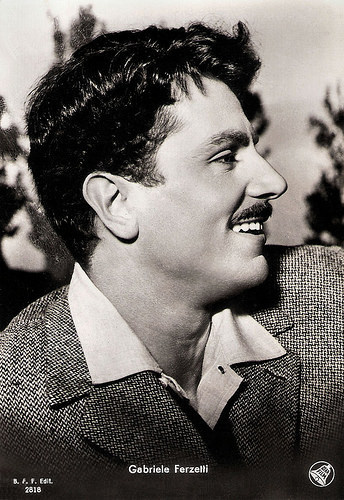
Italian postcard by Casa Editr. Ballerini & Fratini, Firenze (B.F.F. Edit.), no. 2818. Photo: DEAR Film. Publicity still for Puccini (Carmine Gallone, 1953).
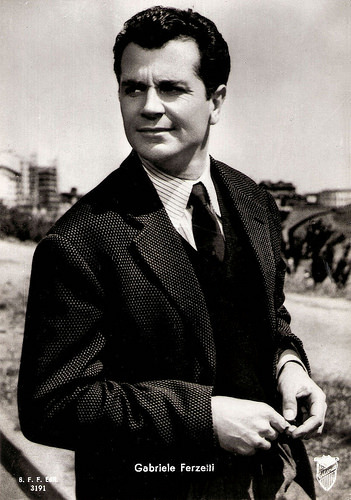
Italian postcard by Casa Editr. Ballerini & Fratini, Firenze (B.F.F. Edit.), no. 3191. Photo: Titanus Film.
Giacomo Puccini
Gabriele Ferzetti was born Pasquale Ferzetti in Rome, Italy in 1925. He studied at the Accademia d'Arte Drammatica in Rome but was expelled after accepting a screen test for his first film. At the age of 17, Ferzetti made his screen debut in the romantic drama Via delle Cinque Lune/Street of the Five Moons (Luigi Chiarini, 1942) featuring Andrea Checchi . That year he also appeared in La contessa Castiglione/The Countess of Castiglione (Flavio Calzavara, 1942) starring Doris Duranti .
He then took a break from film acting and made a succession of theatrical appearances until 1948, when he had a small uncredited role in I miserabili/Les Misérables (Riccardo Freda, 1948). He appeared as Claudio in Fabiola/The Fighting Gladiator (Alessandro Blasetti, 1949), an antiquity drama, set in Rome. The film starring Michèle Morgan , was warmly received.
His first leading role followed in the film Lo Zappatore/The Peasant (Rate Furlan, 1950). The film focused on the life of peasants and farm workers during the depression of the 1930s. During the 1950s, film roles came in abundance for Ferzetti. In quick succession, he began starring in films, from the crime comedy Benvenuto, reverendo!/Welcome Reverend (Aldo Fabrizi, 1950) with Massimo Girotti , to Luis Trenker 's war film Barriera a Settentrione/Mountain Smugglers (1950), and to Curzio Malaparte's drama Il Cristo proibito/The Forbidden Christ (1951) with Raf Vallone .
He portrayed the composer Giacomo Puccini twice: in the biopic Puccini (Carmine Gallone, 1953) and in Casa Ricordi/House of Ricordi (Carmine Gallone, 1954) alongside Roland Alexandre as Gioacchino Rossini. The film was based on the early history of the famous Italian music publishing house Casa Ricordi.
In 1953, Ferzetti starred in La Provinciale/The Wayward Wife (Mario Soldati, 1953), a Cannes Film Festival nominee for best film. In this film he played the role of a professor who falls in love with a glamorous star ( Gina Lollobrigida ). Ferzetti's performance garnered him an award from the Italian National Syndicate of Film Journalists and cemented his status as a leading actor in Italy by appearing alongside La Lollobrigida. He appeared next in the opera adaptation Vestire gli ignudi/Clothe the naked (Marcello Pagliero, 1954), with Pierre Brasseur , and in Camilla (Luciano Emmer, 1954).
Then, Ferzetti starred as a downbeat, struggling artist alongside Eleonora Rossi Drago in Michelangelo Antonioni's Le amiche/The Girlfriends (1955). Robert Firshing at AllMovie : "Le Amiche, based on a 1949 article published in La Bella Estate (Tra donne sole (Among single women) by Cesare Pavese), is perhaps Michelangelo Antonioni's first great film. Juggling 10 characters with great aplomb, Antonioni and co-screenwriters Suso Cecchi D'Amico and Alba De Cespedes have created a rich, interlocking narrative which manages to rise above mere melodrama through careful attention to the ebb and flow of interpersonal relationships and a keen sense of balance."
Another major film was Donatella (Mario Monicelli, 1956) starring Elsa Martinelli . The film was screened at the 6th Berlin International Film Festival. Among his other films are the French historical comedy Le secret du Chevalier d'Éon/The Great Deception (Jacqueline Audry, 1959), and the exciting Peplum Annibale/Hannibal (Carlo Ludovico Bragaglia, 1959) featuring Victor Mature, and set during the Roman Empire.
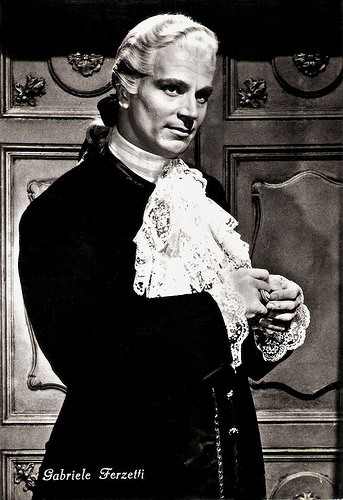
Italian postcard in the Divi del Cinema Series by Vetta Traldi, Milano, no. 92. Photo: publicity still for Le avventure di Giacomo Casanova/The Loves of Casanova (Steno, 1955).

Italian postcard by Bromostampa, Milano, no. 138.
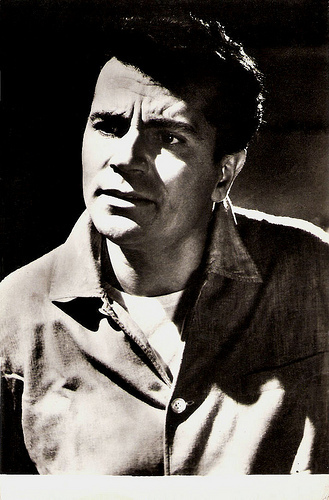
Vintage postcard, no. 3083.
Michelangelo Antonioni
Gabriele Ferzetti made his international breakthrough in Michelangelo Antonioni's controversial L'avventura/The Adventure (1960). He starred as a restless, oversexed playboy alongside Lea Massari and Monica Vitti . This ground-breaking film won a Special Jury Prize at the 1960 Cannes Film Festival and established its director as a major international talent. It also would be Ferzetti's most acclaimed role.
After a series of romantic performances, he acquired a reputation in Italy as an elegant, debonair and a somewhat aristocrat-looking leading man. In 1966, he starred as Lot in John Huston's biblical epic, The Bible: In the Beginning, based on Book of Genesis. He also made his television debut by appearing in two episodes of the cult series I Spy (Robert Butler, 1966).
In 1968, he appeared in Sergio Leone's celebrated western epic C'era una volta il West/Once Upon a Time in the West. He played Morton, the railroad baron, opposite Henry Fonda and Charles Bronson. Then he appeared in the James Bond feature On Her Majesty's Secret Service (Peter Hunt, 1969), perhaps his best known role internationally. He co-starred as distinguished organised crime boss Marc-Ange Draco, the father of Tracy di Vicenzo (Diana Rigg). He promises James Bond (George Lazenby) a handsome dowry for marrying his daughter. However, the two fall in love and marry anyway. Despite speaking good English, Ferzetti’s lines were dubbed by British actor David de Keyser due to Ferzetti's strong Italian accent.
In 1970, he starred in the political thriller L’aveu/The Confession (Costa-Gavras, 1970) opposite Yves Montand and Simone Signoret . The film, based on the book by Lise London, explores the mental tortures facing the vice-minister of the Foreign Affairs of Czechoslovakia when he is imprisoned. The film was nominated for a Golden Globe Award.
Art-house audiences are familiar with Ferzetti for his role in the cult classic Il portiere di notte/The Night Porter (Liliana Cavani, 1974) about the Holocaust. He starred alongside Dirk Bogarde and Charlotte Rampling and played the psychiatrist Hans, one of his most notable roles. Nathan Southern at AllMovie : "On a global scale, Liliana Cavani's The Night Porter sharply divided critics upon release. Reviewers generally fell into two camps - the Euro critics, who almost unanimously hailed it as a masterpiece - and the über-P.C. American commentators, such as Pauline Kael, who referred to it in the New Yorker as 'proof that women can make junk just as well as men.' Roger Ebert even went so far as to blast the film, damning it 'as nasty as it is lubricious, a despicable attempt to titillate us by exploiting memories of persecution and suffering.' Brushing these criticisms aside for a second, The Night Porter, over three decades later, feels strongest in retrospect because Cavani manages - in two hours - to deeply engrave one of the most credible portraits of sadomasochistic bondage ever committed to celluloid, outside of Bertolucci's Last Tango in Paris. Cavani uses the Nazi mystique to climb deeply into the womb of sadomasochism, exposing the inner sicknesses and depravity inherent in S & M - so deeply that the viewing experience becomes palpable, sweat-inducing, and wickedly uncomfortable."
Ferzetti then appeared opposite Laurence Olivier in the historical war film Inchon (Terence Young, 1982), in Il Quartetto Basileus/Basileus Quartet (Fabio Carpi, 1982) and alongside Kathleen Turner in Giulia e Giulia/Julia and Julia (Peter Del Monte, 1987). But his film career declined during the 1980s, and he mainly appeared in TV films and mini-series.
His only role of major note in the 1990s was the Duke of Venice in the William Shakespeare adaptation Othello (Oliver Parker, 1995) starring Laurence Fishburne. His most notable role since then was Nono in the popular French TV series Une famille formidable/A great family, in which he appeared in 11 episodes between 1996 and 2007. Later, he appeared in the lavish, sprawling drama Io sono l'amore/I Am Love (Luca Guadagnino, 2009) and the comedy 18 anni dopo/18 Years Later (Edoardo Leo, 2010) featuring Marco Bonini.
Official French trailer for Le Amiche (1955). Source: Fury Prod. (YouTube).
Criterion Trailer 98: L'Avventura. Source: Criterion Trailers (YouTube).
Official Trailer for On Her Majesty's Secret Service (1969). Source: Movieclips Trailer Vault (YouTube).
Sources: Robert Firsching (AllMovie), Nathan Southern (AllMovie), Hal Erickson (AllMovie), Wikipedia and .

Italian postcard by Casa Editr. Ballerini & Fratini, Firenze (B.F.F. Edit.), no. 2818. Photo: DEAR Film. Publicity still for Puccini (Carmine Gallone, 1953).

Italian postcard by Casa Editr. Ballerini & Fratini, Firenze (B.F.F. Edit.), no. 3191. Photo: Titanus Film.
Giacomo Puccini
Gabriele Ferzetti was born Pasquale Ferzetti in Rome, Italy in 1925. He studied at the Accademia d'Arte Drammatica in Rome but was expelled after accepting a screen test for his first film. At the age of 17, Ferzetti made his screen debut in the romantic drama Via delle Cinque Lune/Street of the Five Moons (Luigi Chiarini, 1942) featuring Andrea Checchi . That year he also appeared in La contessa Castiglione/The Countess of Castiglione (Flavio Calzavara, 1942) starring Doris Duranti .
He then took a break from film acting and made a succession of theatrical appearances until 1948, when he had a small uncredited role in I miserabili/Les Misérables (Riccardo Freda, 1948). He appeared as Claudio in Fabiola/The Fighting Gladiator (Alessandro Blasetti, 1949), an antiquity drama, set in Rome. The film starring Michèle Morgan , was warmly received.
His first leading role followed in the film Lo Zappatore/The Peasant (Rate Furlan, 1950). The film focused on the life of peasants and farm workers during the depression of the 1930s. During the 1950s, film roles came in abundance for Ferzetti. In quick succession, he began starring in films, from the crime comedy Benvenuto, reverendo!/Welcome Reverend (Aldo Fabrizi, 1950) with Massimo Girotti , to Luis Trenker 's war film Barriera a Settentrione/Mountain Smugglers (1950), and to Curzio Malaparte's drama Il Cristo proibito/The Forbidden Christ (1951) with Raf Vallone .
He portrayed the composer Giacomo Puccini twice: in the biopic Puccini (Carmine Gallone, 1953) and in Casa Ricordi/House of Ricordi (Carmine Gallone, 1954) alongside Roland Alexandre as Gioacchino Rossini. The film was based on the early history of the famous Italian music publishing house Casa Ricordi.
In 1953, Ferzetti starred in La Provinciale/The Wayward Wife (Mario Soldati, 1953), a Cannes Film Festival nominee for best film. In this film he played the role of a professor who falls in love with a glamorous star ( Gina Lollobrigida ). Ferzetti's performance garnered him an award from the Italian National Syndicate of Film Journalists and cemented his status as a leading actor in Italy by appearing alongside La Lollobrigida. He appeared next in the opera adaptation Vestire gli ignudi/Clothe the naked (Marcello Pagliero, 1954), with Pierre Brasseur , and in Camilla (Luciano Emmer, 1954).
Then, Ferzetti starred as a downbeat, struggling artist alongside Eleonora Rossi Drago in Michelangelo Antonioni's Le amiche/The Girlfriends (1955). Robert Firshing at AllMovie : "Le Amiche, based on a 1949 article published in La Bella Estate (Tra donne sole (Among single women) by Cesare Pavese), is perhaps Michelangelo Antonioni's first great film. Juggling 10 characters with great aplomb, Antonioni and co-screenwriters Suso Cecchi D'Amico and Alba De Cespedes have created a rich, interlocking narrative which manages to rise above mere melodrama through careful attention to the ebb and flow of interpersonal relationships and a keen sense of balance."
Another major film was Donatella (Mario Monicelli, 1956) starring Elsa Martinelli . The film was screened at the 6th Berlin International Film Festival. Among his other films are the French historical comedy Le secret du Chevalier d'Éon/The Great Deception (Jacqueline Audry, 1959), and the exciting Peplum Annibale/Hannibal (Carlo Ludovico Bragaglia, 1959) featuring Victor Mature, and set during the Roman Empire.

Italian postcard in the Divi del Cinema Series by Vetta Traldi, Milano, no. 92. Photo: publicity still for Le avventure di Giacomo Casanova/The Loves of Casanova (Steno, 1955).

Italian postcard by Bromostampa, Milano, no. 138.

Vintage postcard, no. 3083.
Michelangelo Antonioni
Gabriele Ferzetti made his international breakthrough in Michelangelo Antonioni's controversial L'avventura/The Adventure (1960). He starred as a restless, oversexed playboy alongside Lea Massari and Monica Vitti . This ground-breaking film won a Special Jury Prize at the 1960 Cannes Film Festival and established its director as a major international talent. It also would be Ferzetti's most acclaimed role.
After a series of romantic performances, he acquired a reputation in Italy as an elegant, debonair and a somewhat aristocrat-looking leading man. In 1966, he starred as Lot in John Huston's biblical epic, The Bible: In the Beginning, based on Book of Genesis. He also made his television debut by appearing in two episodes of the cult series I Spy (Robert Butler, 1966).
In 1968, he appeared in Sergio Leone's celebrated western epic C'era una volta il West/Once Upon a Time in the West. He played Morton, the railroad baron, opposite Henry Fonda and Charles Bronson. Then he appeared in the James Bond feature On Her Majesty's Secret Service (Peter Hunt, 1969), perhaps his best known role internationally. He co-starred as distinguished organised crime boss Marc-Ange Draco, the father of Tracy di Vicenzo (Diana Rigg). He promises James Bond (George Lazenby) a handsome dowry for marrying his daughter. However, the two fall in love and marry anyway. Despite speaking good English, Ferzetti’s lines were dubbed by British actor David de Keyser due to Ferzetti's strong Italian accent.
In 1970, he starred in the political thriller L’aveu/The Confession (Costa-Gavras, 1970) opposite Yves Montand and Simone Signoret . The film, based on the book by Lise London, explores the mental tortures facing the vice-minister of the Foreign Affairs of Czechoslovakia when he is imprisoned. The film was nominated for a Golden Globe Award.
Art-house audiences are familiar with Ferzetti for his role in the cult classic Il portiere di notte/The Night Porter (Liliana Cavani, 1974) about the Holocaust. He starred alongside Dirk Bogarde and Charlotte Rampling and played the psychiatrist Hans, one of his most notable roles. Nathan Southern at AllMovie : "On a global scale, Liliana Cavani's The Night Porter sharply divided critics upon release. Reviewers generally fell into two camps - the Euro critics, who almost unanimously hailed it as a masterpiece - and the über-P.C. American commentators, such as Pauline Kael, who referred to it in the New Yorker as 'proof that women can make junk just as well as men.' Roger Ebert even went so far as to blast the film, damning it 'as nasty as it is lubricious, a despicable attempt to titillate us by exploiting memories of persecution and suffering.' Brushing these criticisms aside for a second, The Night Porter, over three decades later, feels strongest in retrospect because Cavani manages - in two hours - to deeply engrave one of the most credible portraits of sadomasochistic bondage ever committed to celluloid, outside of Bertolucci's Last Tango in Paris. Cavani uses the Nazi mystique to climb deeply into the womb of sadomasochism, exposing the inner sicknesses and depravity inherent in S & M - so deeply that the viewing experience becomes palpable, sweat-inducing, and wickedly uncomfortable."
Ferzetti then appeared opposite Laurence Olivier in the historical war film Inchon (Terence Young, 1982), in Il Quartetto Basileus/Basileus Quartet (Fabio Carpi, 1982) and alongside Kathleen Turner in Giulia e Giulia/Julia and Julia (Peter Del Monte, 1987). But his film career declined during the 1980s, and he mainly appeared in TV films and mini-series.
His only role of major note in the 1990s was the Duke of Venice in the William Shakespeare adaptation Othello (Oliver Parker, 1995) starring Laurence Fishburne. His most notable role since then was Nono in the popular French TV series Une famille formidable/A great family, in which he appeared in 11 episodes between 1996 and 2007. Later, he appeared in the lavish, sprawling drama Io sono l'amore/I Am Love (Luca Guadagnino, 2009) and the comedy 18 anni dopo/18 Years Later (Edoardo Leo, 2010) featuring Marco Bonini.
Official French trailer for Le Amiche (1955). Source: Fury Prod. (YouTube).
Criterion Trailer 98: L'Avventura. Source: Criterion Trailers (YouTube).
Official Trailer for On Her Majesty's Secret Service (1969). Source: Movieclips Trailer Vault (YouTube).
Sources: Robert Firsching (AllMovie), Nathan Southern (AllMovie), Hal Erickson (AllMovie), Wikipedia and .
Published on December 03, 2015 22:00
December 2, 2015
Vanessa Redgrave
Vanessa Redgrave (1937) is one of the great actresses of her generation. She started her career in the late 1950s and went on to win the Oscar, Golden Globe, Emmy, and Tony awards. On screen, she has starred in more than 80 films; including such classics as Morgan: A Suitable Case for Treatment (1966), Blowup (1966), Julia (1977), Prick Up Your Ears (1987) and Atonement (2007). On-screen and off, she represents forward-thinking women both, essaying non-conforming free-thinkers like dazzling modern dance pioneer Isadora Duncan in Isadora (1968) and a 19th century American feminist in The Bostonians (1984), while earning her share of controversy for her outspoken political activism.
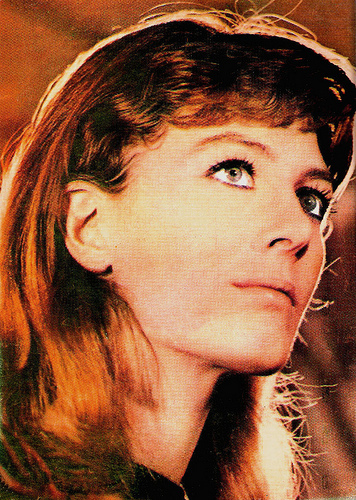
Romanian postcard by Casa Filmului Acin, no. 43 072.
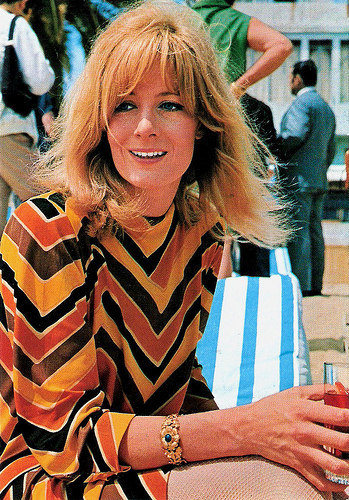
Italian postcard by Rotalcolor, no. 275.
Laertes Has A Daughter
Vanessa Redgrave was born in Greenwich, London in 1937 into an acting dynasty. Her grandparents were actor Roy Redgrave and actress Daisy Scudamore. Vanessa was the daughter of Sir Michael Redgrave and Rachel Kempson, and the older sister of Lynn Redgrave and Corin Redgrave. Laurence Olivier announced her birth in a curtain speech to the audience at a performance of Hamlet at the Old Vic: "Ladies and gentlemen, tonight a great actress has been born; Laertes (played by Michael Redgrave) has a daughter."
She was educated at The Alice Ottley School, Worcester and Queen's Gate School, London. In 1954 she started to train for the stage at the Central School for Speech and Drama in London. She first appeared in the West End in 1958, and a year later she became a member of the acclaimed Stratford-Upon-Avon Theatre Company.
In 1960, Redgrave had her first starring role in Robert Bolt's The Tiger and the Horse, in which she co-starred with her father. Redgrave rose to prominence in 1961 playing Rosalind in As You Like It with the Royal Shakespeare Company and has since made more than 35 appearances on London's West End and on Broadway, winning both the Tony and Olivier Awards.
She made her film debut in the old-fashioned hospital drama Behind the Mask (Brian Desmond Hurst, 1958), in which she played the onscreen daughter of Michael Redgrave . Redgrave would not venture into films again for another eight years, but in 1966 she became a key figure in the 1960s revolution in British film, appearing for New Wave directors, Karel Reisz and her husband, Tony Richardson. She had her first starring role in the seminal Swinging Sixties comedy Morgan: A Suitable Case for Treatment (Karel Reisz, 1966) in which she played the long-suffering ex-wife of a half-mad eccentric artist (David Warner). For her role she earned an Oscar nomination, a Cannes award, a Golden Globe nomination and a BAFTA Film Award nomination.
Redgrave followed Morgan up by playing a mysterious, willowy model in the stylish Blowup (Michelangelo Antonioni, 1966). TCM : “Both pictures helped solidify Redgrave's screen persona as a modern, intelligent woman whose cool and impassive exterior masked a range of conflicting emotions and passions.” For her husband, she starred in The Sailor from Gibraltar (Tony Richardson, 1967), the short and arty Red and Blue (Tony Richardson, 1967), and The Charge of the Light Brigade (Tony Richardson, 1968).
Other highlights of Redgrave's early film career include the role of Guinevere in the Hollywood adaptation of the Lerner and Loewe stage musical Camelot (Joshua Logan, 1967) with Richard Harris and Franco Nero , and her spirited portrayal of modern dance innovator Isadora Duncan in Isadora (Karel Reisz, 1968), for which she won a National Society of Film Critics Award for Best Actress, a second Prize for the Best Female Performance at the Cannes film festival, along with a Golden Globe and Oscar nomination in 1969.
She also appeared in various historical roles – ranging from Andromache in The Trojan Women (Mihalis Kakogiannis, 1971), to the tragic Mary Stuart in Mary, Queen of Scots (Charles Jarrott, 1971). She had also been offered the role of Margaret More in the Oscar-laden story of Sir Thomas More's defiance of Henry VIII, A Man for All Seasons (Fred Zinnemann, 1966), but she had to turn it down due to her stage commitments. She opted for the cameo role of Anne Boleyn instead, and refused to accept any money for this part. Susannah York was cast as Margaret More.
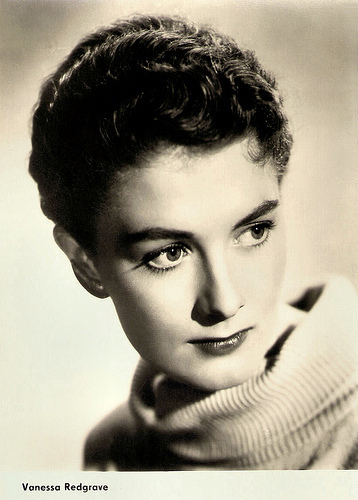
East-German postcard by VEB Progress Filmvertrieb, Berlin, no. 1446, 1961. Retail price: 0,20 DM. Photo: publicity still for Behind the Mask (Brian Desmond-Hurst, 1958).
Source of Controversy
Both Vanessa Redgrave and her sister Lynn were nominated for the 1967 Best Actress Academy Award. Vanessa was nominated for Morgan: A Suitable Case for Treatment (1966) and Lynn for Georgy Girl (Silvio Narizzano, 1966). They both lost to Elizabeth Taylor , who won for Who's Afraid of Virginia Woolf? (Mike Nichols, 1966). That same year, Redgrave was awarded the C.B.E. (Commander of the Order of the British Empire) for her services to drama.
Thirty years later, she allegedly refused the D.B.E. (Dame of the order of the British Empire) in 1999. Since the 1960s, Redgrave has supported a range of political causes, including opposition to the Vietnam War, nuclear disarmament, aid for Bosnian Muslims and other victims of war, and freedom for Soviet Jews. In 1993 she was awarded the Sakharov medal by Sakharov's widow, Yelena Bonner).
In 1977, Redgrave funded and narrated a documentary film on the Palestinian people and the activities of the Palestinian Liberation Organization. That same year she starred in the film Julia (Fred Zinnemann, 1977), based on playwright Lillian Hellman's own friendship with a woman who later enlists her in a fight against the growing tide of Nazism in Europe. Her co-star in the film was Jane Fonda playing Hellman.
When Redgrave was nominated for an Oscar in 1978, for her role in Julia, members of the Jewish Defense League (JDL), led by Rabbi Meir Kahane, burned effigies of Redgrave and picketed the Academy Awards ceremony to protest against both Redgrave and her support of the Palestinian cause. Despite the protests Redgrave's performance in Julia garnered an Academy Award for Best Supporting Actress. However, the controversy had a chilling effect on her career.
In 1980, Redgrave made her American television debut in the Arthur Miller-scripted TV movie Playing for Time (Daniel Mann, 1980) as concentration camp survivor Fania Fénelon who during her internment participated in an all-female orchestra. The decision to cast Redgrave as Fénelon was, however, a source of controversy. In light of Redgrave's support for the Palestine Liberation Organization (PLO), even Fénelon objected to her casting. However, Redgrave won the Emmy as Outstanding Lead Actress in 1981 for this part.
Her opposition to Stalinism led her to join the Workers' Revolutionary Party (WRP), which advocated the dissolution of capitalism and the British monarchy. She ran four times for a seat in the British Parliament as a candidate. In 2004, Vanessa Redgrave and her brother Corin launched the Peace and Progress Party, which campaigned against the Iraq War and for human rights. However, a year later Redgrave left the party.
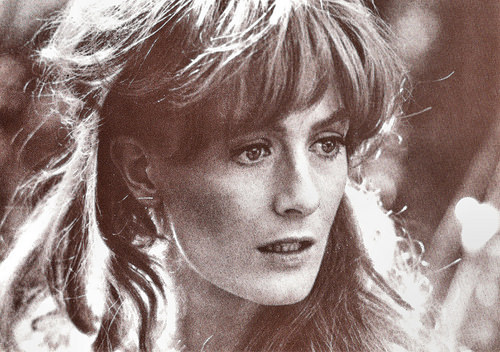
French postcard by Travelling Editions, Paris, no. CP 51, 1987.
More Impressive With Age
In the next decades Vanessa Redgrave balanced turns in big budget productions such as crime boss Max in Mission: Impossible (Brian de Palma, 1996) and a doomed earthling in the summer blockbuster Deep Impact (Mimi Leder, 1998) with stellar performances in smaller, independent films. These included suffragist Olive Chancellor in The Bostonians (James Ivory, 1984), a fourth Best Actress Academy Award nomination); transsexual tennis player Renée Richards in Second Serve (Anthony Page, 1986); and literary agent Peggy Ramsay in the Joe Orton biopic Prick Up Your Ears (Stephen Frears, 1987).
In the next decade followed roles as Mrs. Wilcox in Howards End (James Ivory, 1992); Oscar Wilde’s mother in Wilde (Brian Gilbert, 1997); Clarissa Dalloway in Mrs. Dalloway (Marleen Gorris, 1997); Dr. Sonia Wick in Girl, Interrupted (James Mangold, 1999); and a small part in the Friedrich Dürrenmatt adaptation The Pledge (Sean Penn, 2001). These roles proved that she has grown only more impressive with age.
Her performance as a lesbian grieving the loss of her longtime partner in the HBO series If These Walls Could Talk 2 (Jane Andersen a.o., 2000) earned her a Golden Globe, as well as an Emmy Award. In 2003 she won the Tony Award for her performance in the Broadway revival of Eugene O'Neill's Long Day's Journey Into Night. With this award, she became the sixteenth performer to win the Triple Crown of acting: the Oscar for Best Supporting Actress in Julia (1977), the Tony for Best Actress-Play in Long Day's Journey into Night (2003), and two Emmys for Playing for Time (1980) and If These Walls Could Talk 2 (2000).
Vanessa Redgrave was also the first actress to win the Best Actress award twice at the Cannes Film Festival. She won for Morgan: A Suitable Case for Treatment (Karel Reisz, 1966) and Isadora (Karel Reisz, 1968).
At IMDb , Dale O’Connor writes: “Her rich auburn hair was long, her physique lean, her countenance inscrutable. Three decades later a Redgrave who takes the pictures has hair that is short, the auburn shade muted. The physique is still lean and it is strong from the work it has taken to keep it that way. And the countenance is a lot easier to read. Add expertise with body language and a superb sense of timing and here is a comedienne who should still be carrying films when she is in her 90’s.”
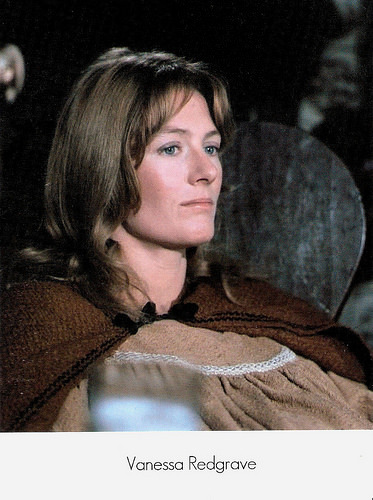
German postcard, no. 17026.
Miscarriage
Vanessa Redgrave married twice. She was married to director Tony Richardson from 1962 till 1967, and they had two children, actresses Natasha Richardson and Joely Richardson. In her 1967 divorce from Richardson she named Jeanne Moreau as co-respondent on grounds of adultery.
Redgrave met the Italian actor Franco Nero during the shooting of Camelot (Joshua Logan, 1967). They had a son Carlo Gabriel Nero (né Carlo Sparanero), now a writer and film director. After filming Mary, Queen of Scots (Charles Jarrott, 1971), The Devils (Ken Russell, 1971) and The Trojan Women (Michael Cacoyannis, 1971), Vanessa Redgrave suffered a miscarriage. The boy would have been her and Franco Nero's second child. Redgrave and Nero separated.
She was then in a long-term relationship with former James Bond actor Timothy Dalton , with whom she had starred in Mary, Queen of Scots (Charles Jarrott, 1971). Since 2006 she is married to her old flame Franco Nero . Her daughter Natasha Richardson tragically passed away in 2009 as the result of a skiing accident at Mont Tremblant, Quebec. After the death of her daughter, Redgrave subsequently dropped out of Ridley Scott's Robin Hood (2010) in which she had a supporting role. Eileen Atkins replaced her.
In the space of just 14 months, she also lost her younger brother and sister, Corin Redgrave and Lynn Redgrave, who died within a month of one another. In October 2010 she returned to the Broadway stage to star in Driving Miss Daisy opposite James Earl Jones. The show received rave reviews. In a poll of ‘industry experts’ and readers conducted by the magazine The Stage in 2010, Redgrave was ranked as the ninth greatest stage actor of all time.
In the cinema she was seen in Letters to Juliet (Gary Winick, 2010) opposite her husband Franco Nero . She also had small roles in the Romanian film Eva (Adrian Popovici, 2010), Julian Schnabel's Palestinian drama Miral (2010), and the Bosnia-set political drama, The Whistleblower (Larysa Kondracki, 2010).
Redgrave played leading lady roles in two historical films, Ralph Fiennes' directorial debut of William Shakespeare's Coriolanus (Ralph Fiennes, 2010) in which Redgrave played Volumnia opposite Fiennes and Gerard Butler; and Anonymous (Roland Emmerich, 2011), a political thriller about who actually wrote the plays of William Shakespeare - Edward De Vere, Earl of Oxford - set against the backdrop of the succession of Queen Elizabeth I (Redgrave), and the Essex Rebellion against her.
Recently, Vanessa Redgrave played supporting parts in such popular films as the American historical drama film The Butler (Lee Daniels, 2013) starring Forest Whitaker and grossing over $176 million worldwide, and the American biographical sports and true crime drama Foxcatcher (Bennett Miller, 2014) starring Steve Carell and Channing Tatum. At the moment of writing this post, her newest film The Secret Scripture (Jim Sheridan, 2016) about a woman keeping a diary of her extended stay at a mental hospital, is in post-production.
Trailer Blow-up (1966). Source: withlotsabutta (YouTube).
Trailer Julia (1977). Source: Wanessa Lima (YouTube).
Trailer Mrs Dalloway (1997). Source: mostern (YouTube).
Sources: Brian McFarlane (Encyclopaedia of British Cinema), (IMDb), TCM, Wikipedia and .

Romanian postcard by Casa Filmului Acin, no. 43 072.

Italian postcard by Rotalcolor, no. 275.
Laertes Has A Daughter
Vanessa Redgrave was born in Greenwich, London in 1937 into an acting dynasty. Her grandparents were actor Roy Redgrave and actress Daisy Scudamore. Vanessa was the daughter of Sir Michael Redgrave and Rachel Kempson, and the older sister of Lynn Redgrave and Corin Redgrave. Laurence Olivier announced her birth in a curtain speech to the audience at a performance of Hamlet at the Old Vic: "Ladies and gentlemen, tonight a great actress has been born; Laertes (played by Michael Redgrave) has a daughter."
She was educated at The Alice Ottley School, Worcester and Queen's Gate School, London. In 1954 she started to train for the stage at the Central School for Speech and Drama in London. She first appeared in the West End in 1958, and a year later she became a member of the acclaimed Stratford-Upon-Avon Theatre Company.
In 1960, Redgrave had her first starring role in Robert Bolt's The Tiger and the Horse, in which she co-starred with her father. Redgrave rose to prominence in 1961 playing Rosalind in As You Like It with the Royal Shakespeare Company and has since made more than 35 appearances on London's West End and on Broadway, winning both the Tony and Olivier Awards.
She made her film debut in the old-fashioned hospital drama Behind the Mask (Brian Desmond Hurst, 1958), in which she played the onscreen daughter of Michael Redgrave . Redgrave would not venture into films again for another eight years, but in 1966 she became a key figure in the 1960s revolution in British film, appearing for New Wave directors, Karel Reisz and her husband, Tony Richardson. She had her first starring role in the seminal Swinging Sixties comedy Morgan: A Suitable Case for Treatment (Karel Reisz, 1966) in which she played the long-suffering ex-wife of a half-mad eccentric artist (David Warner). For her role she earned an Oscar nomination, a Cannes award, a Golden Globe nomination and a BAFTA Film Award nomination.
Redgrave followed Morgan up by playing a mysterious, willowy model in the stylish Blowup (Michelangelo Antonioni, 1966). TCM : “Both pictures helped solidify Redgrave's screen persona as a modern, intelligent woman whose cool and impassive exterior masked a range of conflicting emotions and passions.” For her husband, she starred in The Sailor from Gibraltar (Tony Richardson, 1967), the short and arty Red and Blue (Tony Richardson, 1967), and The Charge of the Light Brigade (Tony Richardson, 1968).
Other highlights of Redgrave's early film career include the role of Guinevere in the Hollywood adaptation of the Lerner and Loewe stage musical Camelot (Joshua Logan, 1967) with Richard Harris and Franco Nero , and her spirited portrayal of modern dance innovator Isadora Duncan in Isadora (Karel Reisz, 1968), for which she won a National Society of Film Critics Award for Best Actress, a second Prize for the Best Female Performance at the Cannes film festival, along with a Golden Globe and Oscar nomination in 1969.
She also appeared in various historical roles – ranging from Andromache in The Trojan Women (Mihalis Kakogiannis, 1971), to the tragic Mary Stuart in Mary, Queen of Scots (Charles Jarrott, 1971). She had also been offered the role of Margaret More in the Oscar-laden story of Sir Thomas More's defiance of Henry VIII, A Man for All Seasons (Fred Zinnemann, 1966), but she had to turn it down due to her stage commitments. She opted for the cameo role of Anne Boleyn instead, and refused to accept any money for this part. Susannah York was cast as Margaret More.

East-German postcard by VEB Progress Filmvertrieb, Berlin, no. 1446, 1961. Retail price: 0,20 DM. Photo: publicity still for Behind the Mask (Brian Desmond-Hurst, 1958).
Source of Controversy
Both Vanessa Redgrave and her sister Lynn were nominated for the 1967 Best Actress Academy Award. Vanessa was nominated for Morgan: A Suitable Case for Treatment (1966) and Lynn for Georgy Girl (Silvio Narizzano, 1966). They both lost to Elizabeth Taylor , who won for Who's Afraid of Virginia Woolf? (Mike Nichols, 1966). That same year, Redgrave was awarded the C.B.E. (Commander of the Order of the British Empire) for her services to drama.
Thirty years later, she allegedly refused the D.B.E. (Dame of the order of the British Empire) in 1999. Since the 1960s, Redgrave has supported a range of political causes, including opposition to the Vietnam War, nuclear disarmament, aid for Bosnian Muslims and other victims of war, and freedom for Soviet Jews. In 1993 she was awarded the Sakharov medal by Sakharov's widow, Yelena Bonner).
In 1977, Redgrave funded and narrated a documentary film on the Palestinian people and the activities of the Palestinian Liberation Organization. That same year she starred in the film Julia (Fred Zinnemann, 1977), based on playwright Lillian Hellman's own friendship with a woman who later enlists her in a fight against the growing tide of Nazism in Europe. Her co-star in the film was Jane Fonda playing Hellman.
When Redgrave was nominated for an Oscar in 1978, for her role in Julia, members of the Jewish Defense League (JDL), led by Rabbi Meir Kahane, burned effigies of Redgrave and picketed the Academy Awards ceremony to protest against both Redgrave and her support of the Palestinian cause. Despite the protests Redgrave's performance in Julia garnered an Academy Award for Best Supporting Actress. However, the controversy had a chilling effect on her career.
In 1980, Redgrave made her American television debut in the Arthur Miller-scripted TV movie Playing for Time (Daniel Mann, 1980) as concentration camp survivor Fania Fénelon who during her internment participated in an all-female orchestra. The decision to cast Redgrave as Fénelon was, however, a source of controversy. In light of Redgrave's support for the Palestine Liberation Organization (PLO), even Fénelon objected to her casting. However, Redgrave won the Emmy as Outstanding Lead Actress in 1981 for this part.
Her opposition to Stalinism led her to join the Workers' Revolutionary Party (WRP), which advocated the dissolution of capitalism and the British monarchy. She ran four times for a seat in the British Parliament as a candidate. In 2004, Vanessa Redgrave and her brother Corin launched the Peace and Progress Party, which campaigned against the Iraq War and for human rights. However, a year later Redgrave left the party.

French postcard by Travelling Editions, Paris, no. CP 51, 1987.
More Impressive With Age
In the next decades Vanessa Redgrave balanced turns in big budget productions such as crime boss Max in Mission: Impossible (Brian de Palma, 1996) and a doomed earthling in the summer blockbuster Deep Impact (Mimi Leder, 1998) with stellar performances in smaller, independent films. These included suffragist Olive Chancellor in The Bostonians (James Ivory, 1984), a fourth Best Actress Academy Award nomination); transsexual tennis player Renée Richards in Second Serve (Anthony Page, 1986); and literary agent Peggy Ramsay in the Joe Orton biopic Prick Up Your Ears (Stephen Frears, 1987).
In the next decade followed roles as Mrs. Wilcox in Howards End (James Ivory, 1992); Oscar Wilde’s mother in Wilde (Brian Gilbert, 1997); Clarissa Dalloway in Mrs. Dalloway (Marleen Gorris, 1997); Dr. Sonia Wick in Girl, Interrupted (James Mangold, 1999); and a small part in the Friedrich Dürrenmatt adaptation The Pledge (Sean Penn, 2001). These roles proved that she has grown only more impressive with age.
Her performance as a lesbian grieving the loss of her longtime partner in the HBO series If These Walls Could Talk 2 (Jane Andersen a.o., 2000) earned her a Golden Globe, as well as an Emmy Award. In 2003 she won the Tony Award for her performance in the Broadway revival of Eugene O'Neill's Long Day's Journey Into Night. With this award, she became the sixteenth performer to win the Triple Crown of acting: the Oscar for Best Supporting Actress in Julia (1977), the Tony for Best Actress-Play in Long Day's Journey into Night (2003), and two Emmys for Playing for Time (1980) and If These Walls Could Talk 2 (2000).
Vanessa Redgrave was also the first actress to win the Best Actress award twice at the Cannes Film Festival. She won for Morgan: A Suitable Case for Treatment (Karel Reisz, 1966) and Isadora (Karel Reisz, 1968).
At IMDb , Dale O’Connor writes: “Her rich auburn hair was long, her physique lean, her countenance inscrutable. Three decades later a Redgrave who takes the pictures has hair that is short, the auburn shade muted. The physique is still lean and it is strong from the work it has taken to keep it that way. And the countenance is a lot easier to read. Add expertise with body language and a superb sense of timing and here is a comedienne who should still be carrying films when she is in her 90’s.”

German postcard, no. 17026.
Miscarriage
Vanessa Redgrave married twice. She was married to director Tony Richardson from 1962 till 1967, and they had two children, actresses Natasha Richardson and Joely Richardson. In her 1967 divorce from Richardson she named Jeanne Moreau as co-respondent on grounds of adultery.
Redgrave met the Italian actor Franco Nero during the shooting of Camelot (Joshua Logan, 1967). They had a son Carlo Gabriel Nero (né Carlo Sparanero), now a writer and film director. After filming Mary, Queen of Scots (Charles Jarrott, 1971), The Devils (Ken Russell, 1971) and The Trojan Women (Michael Cacoyannis, 1971), Vanessa Redgrave suffered a miscarriage. The boy would have been her and Franco Nero's second child. Redgrave and Nero separated.
She was then in a long-term relationship with former James Bond actor Timothy Dalton , with whom she had starred in Mary, Queen of Scots (Charles Jarrott, 1971). Since 2006 she is married to her old flame Franco Nero . Her daughter Natasha Richardson tragically passed away in 2009 as the result of a skiing accident at Mont Tremblant, Quebec. After the death of her daughter, Redgrave subsequently dropped out of Ridley Scott's Robin Hood (2010) in which she had a supporting role. Eileen Atkins replaced her.
In the space of just 14 months, she also lost her younger brother and sister, Corin Redgrave and Lynn Redgrave, who died within a month of one another. In October 2010 she returned to the Broadway stage to star in Driving Miss Daisy opposite James Earl Jones. The show received rave reviews. In a poll of ‘industry experts’ and readers conducted by the magazine The Stage in 2010, Redgrave was ranked as the ninth greatest stage actor of all time.
In the cinema she was seen in Letters to Juliet (Gary Winick, 2010) opposite her husband Franco Nero . She also had small roles in the Romanian film Eva (Adrian Popovici, 2010), Julian Schnabel's Palestinian drama Miral (2010), and the Bosnia-set political drama, The Whistleblower (Larysa Kondracki, 2010).
Redgrave played leading lady roles in two historical films, Ralph Fiennes' directorial debut of William Shakespeare's Coriolanus (Ralph Fiennes, 2010) in which Redgrave played Volumnia opposite Fiennes and Gerard Butler; and Anonymous (Roland Emmerich, 2011), a political thriller about who actually wrote the plays of William Shakespeare - Edward De Vere, Earl of Oxford - set against the backdrop of the succession of Queen Elizabeth I (Redgrave), and the Essex Rebellion against her.
Recently, Vanessa Redgrave played supporting parts in such popular films as the American historical drama film The Butler (Lee Daniels, 2013) starring Forest Whitaker and grossing over $176 million worldwide, and the American biographical sports and true crime drama Foxcatcher (Bennett Miller, 2014) starring Steve Carell and Channing Tatum. At the moment of writing this post, her newest film The Secret Scripture (Jim Sheridan, 2016) about a woman keeping a diary of her extended stay at a mental hospital, is in post-production.
Trailer Blow-up (1966). Source: withlotsabutta (YouTube).
Trailer Julia (1977). Source: Wanessa Lima (YouTube).
Trailer Mrs Dalloway (1997). Source: mostern (YouTube).
Sources: Brian McFarlane (Encyclopaedia of British Cinema), (IMDb), TCM, Wikipedia and .
Published on December 02, 2015 22:00
December 1, 2015
Das Mirakel (1912)
Das Mirakel (The Miracle) is a German play written by Karl Vollmöller in 1911. That same year Max Reinhardt staged a spectacle-pantomime in Berlin in 1911. Later, three films were made. But for which film or stage version of Das Mirakel were the postcards in this post created?
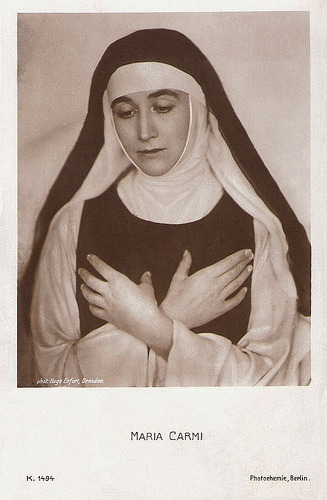
German postcard by Photochemie, Berlin, no. K 1494. Photo: Hugo Erfurt, Dresden. Publicity still for The Miracle (1912) with Maria Carmi .
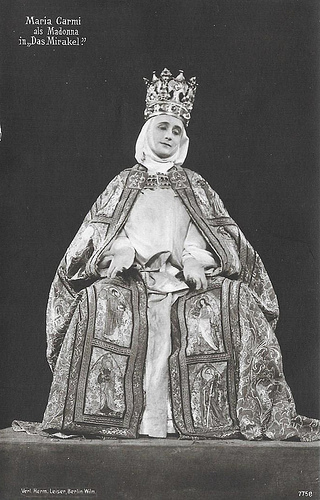
German postcard by Verlag Hermann Leiser, Berlin-Wilmersdorf, no. 7758. Publicity still for The Miracle (1912) with Maria Carmi . Collection: Didier Hanson.
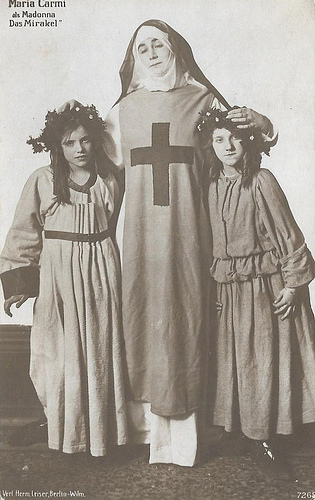
Maria Carmi. German postcard by Verlag Hermann Leiser, Berlin-Wilmersdorf, no. 7268. Publicity still for The Miracle. Collection: Didier Hanson.
Spectacle-pantomime
Das Mirakel (The Miracle) first appeared as a spectacle-pantomime in Germany in 1911. Later in 1911, the play also opened in London and played to huge audiences at the Olympia, the London exhibition hall.
Das Mirakel re-tells an old legend about a nun in the Middle Ages who runs away from her convent with a knight. She has several adventures, eventually leading to her being accused of witchcraft. During her absence, the statue of the Virgin Mary in the convent's chapel comes to life and takes the nun's place in the convent, until her safe return. Then she becomes a statue again.
The play's stage director was Max Reinhardt, the Austrian theatrical genius, whose inspired use of lighting, mechanical effects and spectacle (particularly crowds) startled audiences across Europe. He told the story of Das Mirakel without words in a cathedral setting. 1,000 performers and 500 choristers and 25 horses filled out the epic drama, supported by a wonderful array of stage mechanics, ingenious theatrical effects and music of the great composer Engelbert Humperdink played by an orchestra of 2,000. For many the spectacular Das Mirakel was a theatrical event like no other.
Das Mirakel launched the career of Italian silent film star and stage actress Maria Carmi (1880-1957), who interpreted the virgin Mary. With her aristocratic air, her severe looks but also her sweet undertones, Carmi was the cinematic translation of the 19th century Primadonna. Later she became Princess Norina Matchabelli and was co-founder of the perfume company Prince Matchabelli.
In 1924, Das Mirakel was revived on Broadway, after a tour of Detroit, Milwaukee and Dallas. The New York version, which opened 16 January 1924 at the Century Theatre was produced by Morris Gest, and starred Rosamond Pinchot as the Nun, and Lady Diana Cooper and Maria Carmi alternating nightly in the role of the Madonna.
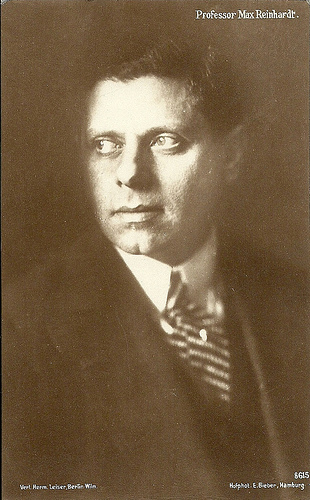
Max Reinhardt. German postcard by Verlag Hermann Leiser, Berlin, no. 8615. Photo: Hofphot. E. Bieber, Hamburg. Collection: Didier Hanson.
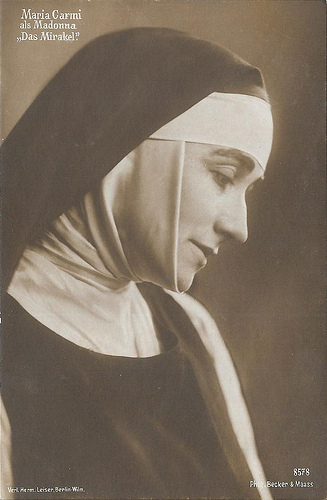
Maria Carmi. German postcard by Verlag Hermann Leiser, Berlin-Wilmersdorf, no. 8578. Photo: Becker & Maass. Publicity still for Das Mirakel/The Miracle. Collection: Didier Hanson.
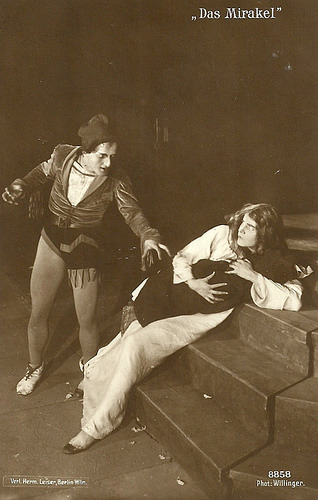
German postcard by Verlag Hermann Leiser, Berlin, no. 8858. Photo: Willinger. German postcard for either the stage play Das Mirakel (1911) or the Austrian-British film Das Mirakel/The Miracle (1912). The postcard shows Ernst Matray as the Evil Genius and probably Florence Winston as Megildis, the nun who has escaped the convent and now has a baby.
A full-length, hand-coloured film
Das Mirakel/The Miracle was adapted to three different film versions. The original authorised version, The Miracle (1912), was a full-length, hand-coloured film, which was shot in Austria in 1912 but was a British production. The exteriors were photographed in the grounds of Kreuzenstein Castle and at the cathedral of Perchtoldsdorf, Vienna.
The Miracle (1912) was produced by Joseph Menchen and (probably) directed by French actor, stage director and film director Michel Carré, who also wrote the screenplay. IMDb wrongly suggests the film is called Das Mirakel and was directed by wildlife filmmaker Cherry Kearton and by Max Reinhardt himself. Reinhardt had little to do with the film’s actual production.
The stars were Maria Carmi as The Madonna, Ernst Matray as Spielmann (the minstrel), and Florence Winston as the Nun. The Hungarian Matray was an acclaimed stage actor, who had been playing with Max Reinhardt's Deutsches Theater since 1907.
Instead the British Florence Winston was an unknown actress. In the stage version her role had been played by someone else. According to Luke McKernan at his site The Bioscope , Winston's only claim to fame was that she was the wife of William Jeapes, one of the film's cinematographers, together with his brother Harold. The two brothers were known as newsreel cinematographers.William Jeapes ran the popular British newsreel Topical Budget, but nothing is known about whether they had any previous experience of fiction film making.
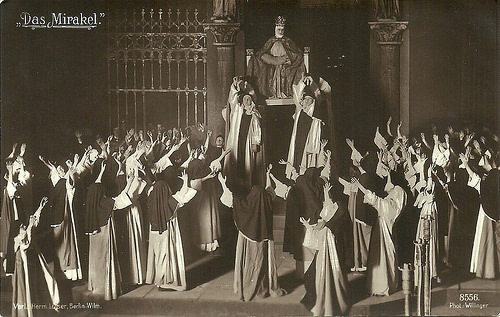
German postcard by Verlag Hermann Leiser, Berlin, no. 8556. Photo: Willinger. Publicity still for either the stage play Das Mirakel (1911) or the Austrian-British film Das Mirakel/The Miracle (1912).
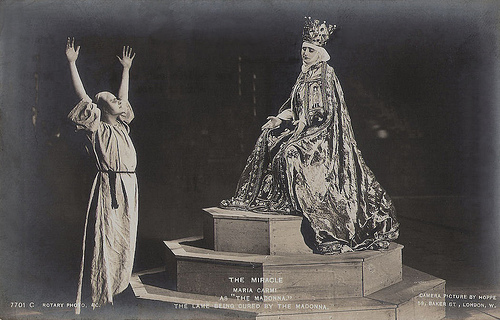
British postcard by Rotary Photo, no. 7701 C. Photo: Hoppe, London. Publicity still of the London stage production of Das Mirakel/The Miracle (Max Reinhardt, 1912) with Maria Carmi as the Madonna. Here she has just cured the lame.
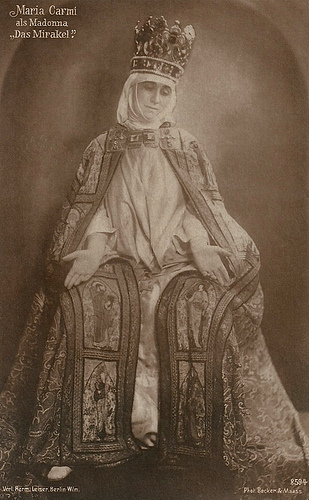
Maria Carmi. German postcard by Verlag Hermann Leiser, Berlin-Wilmersdorf, no. 8594. Photo: Becker & Maass.
Multimedia experience
The Miracle (Michel Carré, 1912) was not intended to be shown as an ordinary film in the usual way, but was designed by Joseph Menchen to be shown as part of a 'Lyricscope play'. This was an unusual (if not unique) spectacular theatrical presentation which - in its most elaborate and complete expression - included: the projected colour film, a full-sized symphony orchestra and chorus, live sound effects such as church bells and crowd noises, stage sets around the projection screen which changed during the performance, and live (non-speaking) actors and dancers in medieval costume.
Joseph Menchen was a London-based American inventor, film projectionist and owner of a New York theatrical lighting business. He later became a literary agent for film scripts. The various component parts of his production of Das Mirakel varied somewhat according to local conditions.
The world premiere took place at the Royal Opera House, Covent Garden, London, on 21 December 1912. It was released in Germany in August 1914 and premiered at the Circus Busch.
In 1912 an unauthorised German version was also filmed, titled Das Mirakel. It was directed by Mime Misu for Continental-Kunstfilm in Germany. Mime Misu was a Romanian who had come to prominence in German cinema following the success of his dramatisation of the tragic story of the sinking of the ‘Titanic’, In Nacht und Eis/In night and ice (1912). Misu has not only directed the film, but acts in it as well, alongside Lore Giesen and Ernst Rückert. The production was the subject of various copyright legal actions in the UK and the USA, resulting in seven different titles shared between the two films.
In 1959 the play was adapted to film a third time by Warner Brothers, again titled The Miracle, directed by Irving Rapper.
The first film version, The Miracle (Michel Carré, 1912) was considered lost for a long time. A tinted print was discovered and saved in recent times at the CNC in Bois d'Arcy. At the time, The Miracle was a prestigious production, but nowadays it fails to capture this. This is because of its antiquated style, even for 1912, but also because of the lack of the multimedia experience around its original showings.
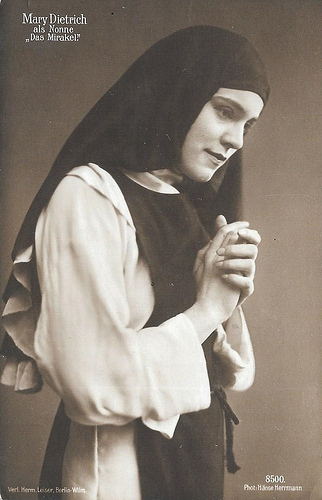
German postcard by Verlag Hermann Leiser, Berlin-Wilmersdorf, no. 8500. Photo: Hänse Hermann. Publicity still for Das Mirakel/The Miracle with Mary Dietrich. Collection: Didier Hanson.
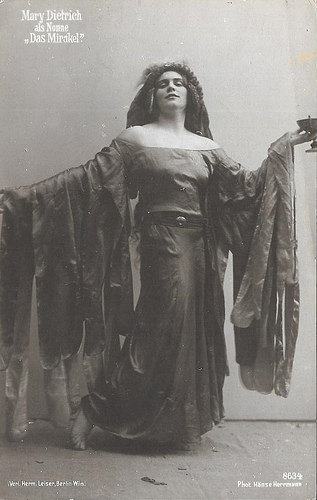
German postcard by Verlag Hermann Leiser, Berlin-Wilmersdorf, no. 8634. Photo: Hänse Hermann. Publicity still for Das Mirakel/The Miracle with Mary Dietrich. Collection: Didier Hanson.
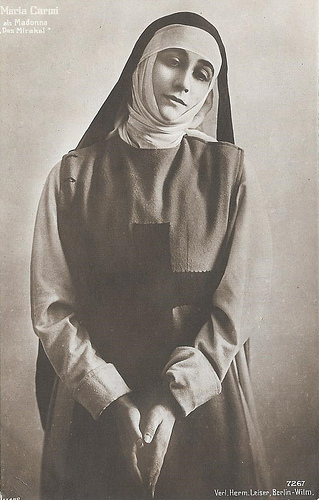
Maria Carmi. German postcard by Verlag Hermann Leiser, Berlin-Wilmersdorf, no. 7267. Collection: Didier Hanson.
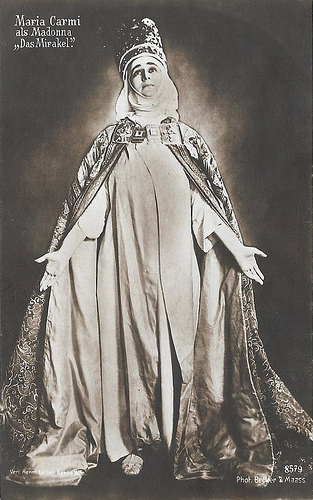
German postcard by Verlag Hermann Leiser, no. 8579. Photo: Becker & Maass. Publicity still for Das Mirakel/The Miracle with Maria Carmi as the Madonna.
Sources: Luke McKernan (The Bioscope), Wikipedia and IMDb,

German postcard by Photochemie, Berlin, no. K 1494. Photo: Hugo Erfurt, Dresden. Publicity still for The Miracle (1912) with Maria Carmi .

German postcard by Verlag Hermann Leiser, Berlin-Wilmersdorf, no. 7758. Publicity still for The Miracle (1912) with Maria Carmi . Collection: Didier Hanson.

Maria Carmi. German postcard by Verlag Hermann Leiser, Berlin-Wilmersdorf, no. 7268. Publicity still for The Miracle. Collection: Didier Hanson.
Spectacle-pantomime
Das Mirakel (The Miracle) first appeared as a spectacle-pantomime in Germany in 1911. Later in 1911, the play also opened in London and played to huge audiences at the Olympia, the London exhibition hall.
Das Mirakel re-tells an old legend about a nun in the Middle Ages who runs away from her convent with a knight. She has several adventures, eventually leading to her being accused of witchcraft. During her absence, the statue of the Virgin Mary in the convent's chapel comes to life and takes the nun's place in the convent, until her safe return. Then she becomes a statue again.
The play's stage director was Max Reinhardt, the Austrian theatrical genius, whose inspired use of lighting, mechanical effects and spectacle (particularly crowds) startled audiences across Europe. He told the story of Das Mirakel without words in a cathedral setting. 1,000 performers and 500 choristers and 25 horses filled out the epic drama, supported by a wonderful array of stage mechanics, ingenious theatrical effects and music of the great composer Engelbert Humperdink played by an orchestra of 2,000. For many the spectacular Das Mirakel was a theatrical event like no other.
Das Mirakel launched the career of Italian silent film star and stage actress Maria Carmi (1880-1957), who interpreted the virgin Mary. With her aristocratic air, her severe looks but also her sweet undertones, Carmi was the cinematic translation of the 19th century Primadonna. Later she became Princess Norina Matchabelli and was co-founder of the perfume company Prince Matchabelli.
In 1924, Das Mirakel was revived on Broadway, after a tour of Detroit, Milwaukee and Dallas. The New York version, which opened 16 January 1924 at the Century Theatre was produced by Morris Gest, and starred Rosamond Pinchot as the Nun, and Lady Diana Cooper and Maria Carmi alternating nightly in the role of the Madonna.

Max Reinhardt. German postcard by Verlag Hermann Leiser, Berlin, no. 8615. Photo: Hofphot. E. Bieber, Hamburg. Collection: Didier Hanson.

Maria Carmi. German postcard by Verlag Hermann Leiser, Berlin-Wilmersdorf, no. 8578. Photo: Becker & Maass. Publicity still for Das Mirakel/The Miracle. Collection: Didier Hanson.

German postcard by Verlag Hermann Leiser, Berlin, no. 8858. Photo: Willinger. German postcard for either the stage play Das Mirakel (1911) or the Austrian-British film Das Mirakel/The Miracle (1912). The postcard shows Ernst Matray as the Evil Genius and probably Florence Winston as Megildis, the nun who has escaped the convent and now has a baby.
A full-length, hand-coloured film
Das Mirakel/The Miracle was adapted to three different film versions. The original authorised version, The Miracle (1912), was a full-length, hand-coloured film, which was shot in Austria in 1912 but was a British production. The exteriors were photographed in the grounds of Kreuzenstein Castle and at the cathedral of Perchtoldsdorf, Vienna.
The Miracle (1912) was produced by Joseph Menchen and (probably) directed by French actor, stage director and film director Michel Carré, who also wrote the screenplay. IMDb wrongly suggests the film is called Das Mirakel and was directed by wildlife filmmaker Cherry Kearton and by Max Reinhardt himself. Reinhardt had little to do with the film’s actual production.
The stars were Maria Carmi as The Madonna, Ernst Matray as Spielmann (the minstrel), and Florence Winston as the Nun. The Hungarian Matray was an acclaimed stage actor, who had been playing with Max Reinhardt's Deutsches Theater since 1907.
Instead the British Florence Winston was an unknown actress. In the stage version her role had been played by someone else. According to Luke McKernan at his site The Bioscope , Winston's only claim to fame was that she was the wife of William Jeapes, one of the film's cinematographers, together with his brother Harold. The two brothers were known as newsreel cinematographers.William Jeapes ran the popular British newsreel Topical Budget, but nothing is known about whether they had any previous experience of fiction film making.

German postcard by Verlag Hermann Leiser, Berlin, no. 8556. Photo: Willinger. Publicity still for either the stage play Das Mirakel (1911) or the Austrian-British film Das Mirakel/The Miracle (1912).

British postcard by Rotary Photo, no. 7701 C. Photo: Hoppe, London. Publicity still of the London stage production of Das Mirakel/The Miracle (Max Reinhardt, 1912) with Maria Carmi as the Madonna. Here she has just cured the lame.

Maria Carmi. German postcard by Verlag Hermann Leiser, Berlin-Wilmersdorf, no. 8594. Photo: Becker & Maass.
Multimedia experience
The Miracle (Michel Carré, 1912) was not intended to be shown as an ordinary film in the usual way, but was designed by Joseph Menchen to be shown as part of a 'Lyricscope play'. This was an unusual (if not unique) spectacular theatrical presentation which - in its most elaborate and complete expression - included: the projected colour film, a full-sized symphony orchestra and chorus, live sound effects such as church bells and crowd noises, stage sets around the projection screen which changed during the performance, and live (non-speaking) actors and dancers in medieval costume.
Joseph Menchen was a London-based American inventor, film projectionist and owner of a New York theatrical lighting business. He later became a literary agent for film scripts. The various component parts of his production of Das Mirakel varied somewhat according to local conditions.
The world premiere took place at the Royal Opera House, Covent Garden, London, on 21 December 1912. It was released in Germany in August 1914 and premiered at the Circus Busch.
In 1912 an unauthorised German version was also filmed, titled Das Mirakel. It was directed by Mime Misu for Continental-Kunstfilm in Germany. Mime Misu was a Romanian who had come to prominence in German cinema following the success of his dramatisation of the tragic story of the sinking of the ‘Titanic’, In Nacht und Eis/In night and ice (1912). Misu has not only directed the film, but acts in it as well, alongside Lore Giesen and Ernst Rückert. The production was the subject of various copyright legal actions in the UK and the USA, resulting in seven different titles shared between the two films.
In 1959 the play was adapted to film a third time by Warner Brothers, again titled The Miracle, directed by Irving Rapper.
The first film version, The Miracle (Michel Carré, 1912) was considered lost for a long time. A tinted print was discovered and saved in recent times at the CNC in Bois d'Arcy. At the time, The Miracle was a prestigious production, but nowadays it fails to capture this. This is because of its antiquated style, even for 1912, but also because of the lack of the multimedia experience around its original showings.

German postcard by Verlag Hermann Leiser, Berlin-Wilmersdorf, no. 8500. Photo: Hänse Hermann. Publicity still for Das Mirakel/The Miracle with Mary Dietrich. Collection: Didier Hanson.

German postcard by Verlag Hermann Leiser, Berlin-Wilmersdorf, no. 8634. Photo: Hänse Hermann. Publicity still for Das Mirakel/The Miracle with Mary Dietrich. Collection: Didier Hanson.

Maria Carmi. German postcard by Verlag Hermann Leiser, Berlin-Wilmersdorf, no. 7267. Collection: Didier Hanson.

German postcard by Verlag Hermann Leiser, no. 8579. Photo: Becker & Maass. Publicity still for Das Mirakel/The Miracle with Maria Carmi as the Madonna.
Sources: Luke McKernan (The Bioscope), Wikipedia and IMDb,
Published on December 01, 2015 22:00
November 30, 2015
Agnes Esterhazy
Hungarian film actress (Gräfin) Agnes Esterhazy (1891-1956) worked mainly in the silent cinema of Austria and Germany. The countess appeared in more than 30 films between 1920 and 1943.
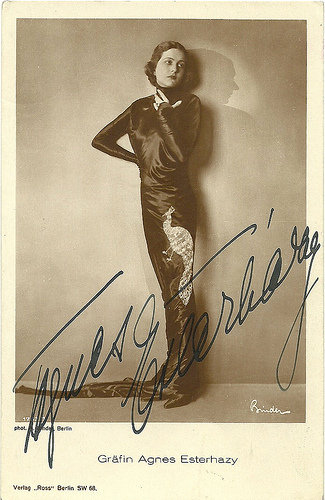
German postcard by Ross Verlag, no. 1743/1, 1927-1928. Photo: Alex Binder. Collection: Didier Hanson.
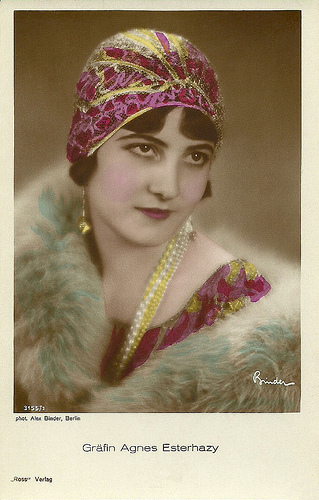
German postcard by Ross Verlag, no. 3155/1, 1928-1929. Photo: Alex Binder. Collection: Didier Hanson.
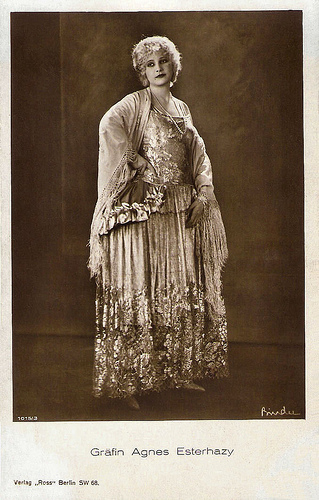
German postcard by Ross Verlag, no. 1015/3, 1927-1928. Photo: Alex Binder.
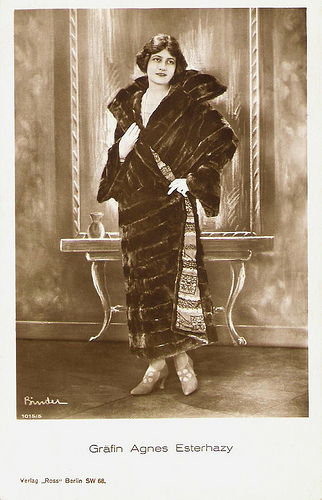
German postcard by Ross Verlag, no. 1015/5, 1927-1928. Photo: Alex Binder.
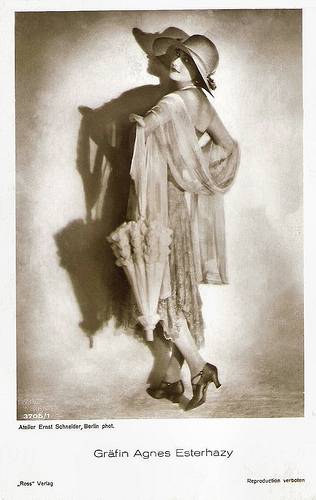
German postcard by Ross Verlag, no. 3705/1, 1928-1929. Photo: Ernst Schneider, Berlin.
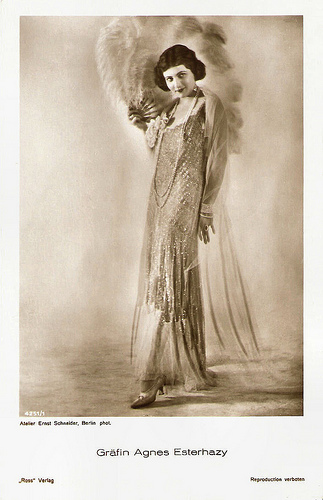
German postcard by Ross Verlag, no. 4251/3, 1929-1930. Photo: Ernst Schneider, Berlin.
Vienna - Munich - Berlin
Agnes Esterhazy was born Agnes Gräfin Josika von Branyitska in Klausenburg/Kolozsvár, Austria-Hungary (now Cluj-Napoca, Romania), in 1891 (some sources say 1898). She was a real countess, the daughter of Count Josika von Branyitska and his wife.
In Budapest she took acting classes from singer/actress Ilka Pálmay and worked for the Városi Színház (the Municipal theater). She made her first film appearance in the Hungarian film A szerelem mindent legyőz/Love Surrenders Everything (László Márkus, 1920).
In 1923 she was invited by Sascha-Film to come to Vienna. There she made the Arthur Schnitzler adaptation Der Junge Medardus/Young Medardus (1923), directed by Mihaly Kertész, the later Michael Curtiz. This was a historical film about a young man from Vienna who wants to fight against the Napoleon troops.
Then Esterhazy left for Munich and soon moved further to Berlin, the European film capital at the time. In Berlin she appeared for Trianon-Film in Zwei Menschen/Two People (Hanns Schwarz, 1924) opposite Olaf Ford , and Nanon (Hanns Schwarz, 1924) with Harry Liedtke .
She appeared in such silent classics as Die freudlose Gasse/The Joyless Street (Georg Wilhelm Pabst, 1925) starring Asta Nielsen and the young Greta Garbo , and the horror film Der Student von Prag/The Man Who Cheated Life (Henrik Galeen, 1926) featuring Conrad Veidt .
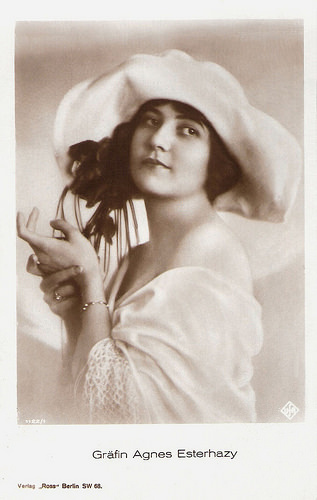
German postcard by Ross Verlag, no. 1122/1, 1927-1928. Photo: Ufa.
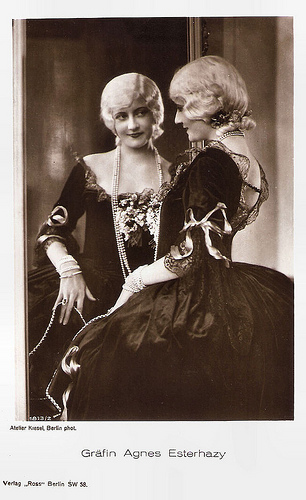
German postcard by Ross Verlag, no. 1813/2, 1927-1928. Photo: Atelier Kiesel, Berlin.
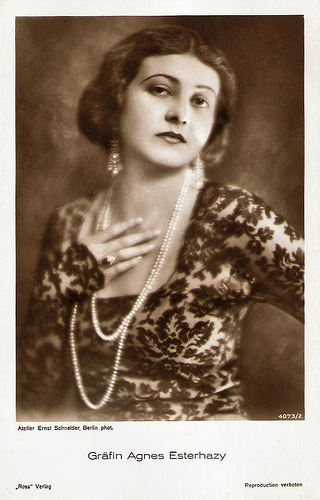
German postcard by Ross Verlag, no. 4073/2, 1929-1930. Photo: Atelier Ernst Schneider.
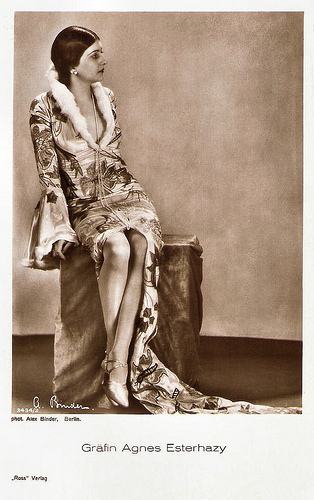
German postcard by Ross Verlag, no. 3434/2, 1928-1929. Photo: Alex Binder, Berlin.
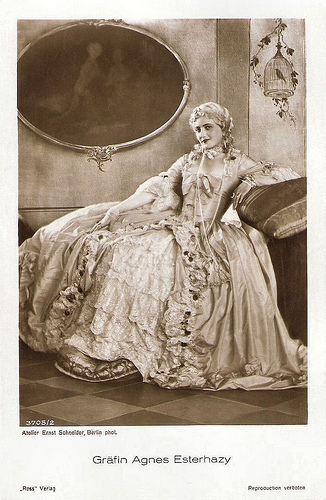
German postcard by Ross Verlag, no. 3705/2, 1928-1929. Photo: Atelier Ernst Schneider.
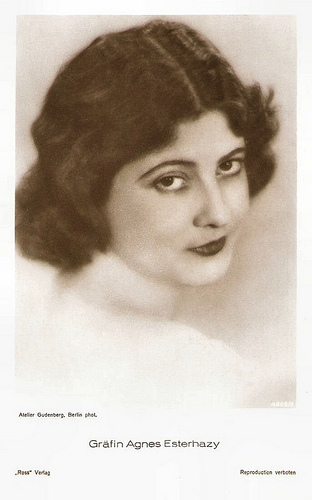
German postcard by Ross Verlag, no. 4869/2, 1929-1930. Photo: Atelier Gudenberg, Berlin.
Supporting and Leading Parts
Agnes Esterhazy played many supporting parts in silent German films of the 1920s and eventually she also appeared in leading parts in such films as Die Spielerin/The Player (Graham Cutts, 1927), and Der Bettelstudent/The Beggar Student (Jakob Fleck, Luise Fleck, 1927), both with Harry Liedtke .
Under the direction of Karl Grune she appeared in the historical drama Marquis d'Eon, der Spion der Pompadour/Marquis d'Eon, the Spy of Pompadour (Karl Grune, 1928) with Liane Haid .
But with the arrival of the sound film, her film career practically ended. She appeared in a few early sound films such as the comedy Die Garde-Diva (Curt Blachnitzky, 1929) with Georg Alexander, and Liebe und Champagner/Love and Champagne (Robert Land, 1930) with Iván Petrovich , but then she retired from the cinema.
The following decade she worked on stage, especially in Ostrau. In 1943 she appeared for one last time in a film, in Gabriele Dambrone (Hans Steinhoff, 1943) with Gusti Huber. She was married to actor Fritz Schulz .
Agnes Esterhazy died in Budapest, Hungary (some sources say: München (Munich), Germany), in 1956.

German postcard by Ross Verlag, Berlin, no. 91/1. Photo: Aafa. Publicity still for Der Bettelstudent/The Beggar Student (Jacob Fleck, Luise Fleck, 1927) with Harry Liedtke .

German postcard by Ross Verlag, Berlin, no. 91/5. Photo: Aafa. Publicity still for Der Bettelstudent/The Beggar Student (Jacob Fleck, Luise Fleck, 1927). Collection: Didier Hanson.
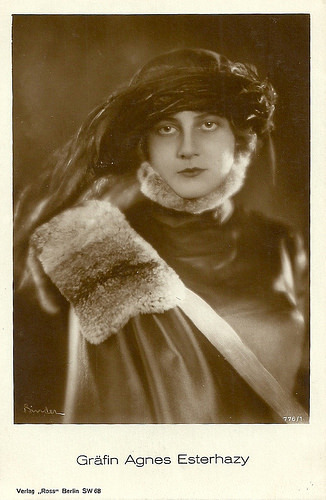
German postcard by Ross Verlag, no. 776/1, 1925-1926. Photo: Alex Binder.
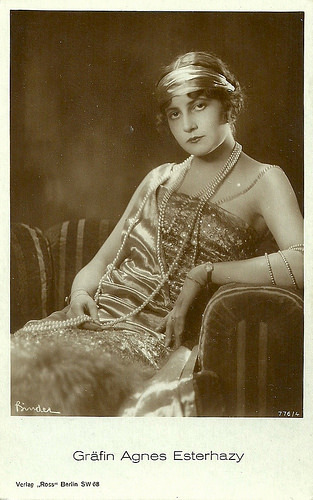
German postcard by Ross Verlag, no. 776/4, 1925-1926. Photo: Alex Binder.
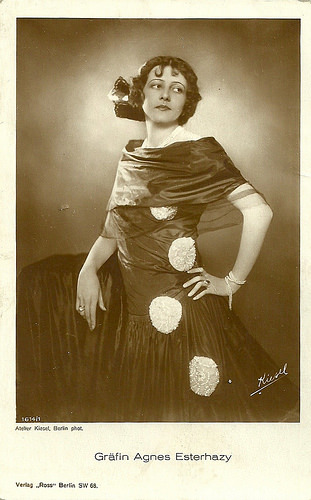
German postcard by Ross Verlag, no. 1614/1, 1927-1928. Photo: Atelier Kiesel, Berlin.
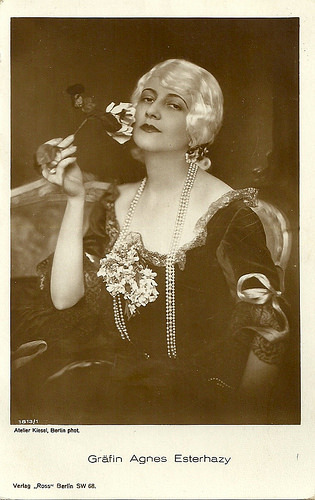
German postcard by Ross Verlag, no. 1813/1, 1927-1928. Photo: Atelier Kiesel, Berlin.
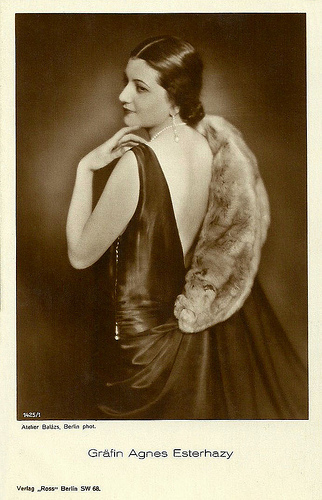
German postcard by Ross Verlag, no. 1425/1, 1927-1928. Photo: Atelier Balàzs, Berlin.
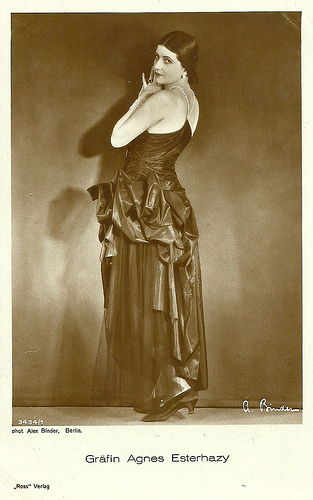
German postcard by Ross Verlag, no. 3434/1, 1928-1929. Photo: Alex Binder, Berlin.
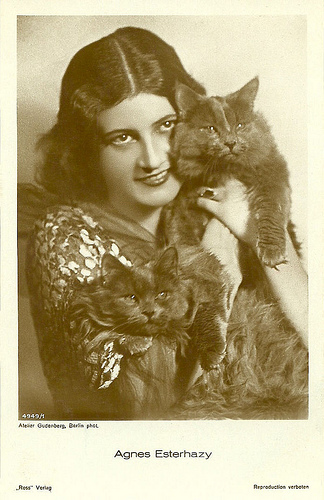
German postcard by Ross Verlag, no. 4949/1, 1929-1930. Photo: Atelier Gudenburg. Collection: Didier Hanson.
Sources: Thomas Staedeli (Cyranos), Wikipedia and .

German postcard by Ross Verlag, no. 1743/1, 1927-1928. Photo: Alex Binder. Collection: Didier Hanson.

German postcard by Ross Verlag, no. 3155/1, 1928-1929. Photo: Alex Binder. Collection: Didier Hanson.

German postcard by Ross Verlag, no. 1015/3, 1927-1928. Photo: Alex Binder.

German postcard by Ross Verlag, no. 1015/5, 1927-1928. Photo: Alex Binder.

German postcard by Ross Verlag, no. 3705/1, 1928-1929. Photo: Ernst Schneider, Berlin.

German postcard by Ross Verlag, no. 4251/3, 1929-1930. Photo: Ernst Schneider, Berlin.
Vienna - Munich - Berlin
Agnes Esterhazy was born Agnes Gräfin Josika von Branyitska in Klausenburg/Kolozsvár, Austria-Hungary (now Cluj-Napoca, Romania), in 1891 (some sources say 1898). She was a real countess, the daughter of Count Josika von Branyitska and his wife.
In Budapest she took acting classes from singer/actress Ilka Pálmay and worked for the Városi Színház (the Municipal theater). She made her first film appearance in the Hungarian film A szerelem mindent legyőz/Love Surrenders Everything (László Márkus, 1920).
In 1923 she was invited by Sascha-Film to come to Vienna. There she made the Arthur Schnitzler adaptation Der Junge Medardus/Young Medardus (1923), directed by Mihaly Kertész, the later Michael Curtiz. This was a historical film about a young man from Vienna who wants to fight against the Napoleon troops.
Then Esterhazy left for Munich and soon moved further to Berlin, the European film capital at the time. In Berlin she appeared for Trianon-Film in Zwei Menschen/Two People (Hanns Schwarz, 1924) opposite Olaf Ford , and Nanon (Hanns Schwarz, 1924) with Harry Liedtke .
She appeared in such silent classics as Die freudlose Gasse/The Joyless Street (Georg Wilhelm Pabst, 1925) starring Asta Nielsen and the young Greta Garbo , and the horror film Der Student von Prag/The Man Who Cheated Life (Henrik Galeen, 1926) featuring Conrad Veidt .

German postcard by Ross Verlag, no. 1122/1, 1927-1928. Photo: Ufa.

German postcard by Ross Verlag, no. 1813/2, 1927-1928. Photo: Atelier Kiesel, Berlin.

German postcard by Ross Verlag, no. 4073/2, 1929-1930. Photo: Atelier Ernst Schneider.

German postcard by Ross Verlag, no. 3434/2, 1928-1929. Photo: Alex Binder, Berlin.

German postcard by Ross Verlag, no. 3705/2, 1928-1929. Photo: Atelier Ernst Schneider.

German postcard by Ross Verlag, no. 4869/2, 1929-1930. Photo: Atelier Gudenberg, Berlin.
Supporting and Leading Parts
Agnes Esterhazy played many supporting parts in silent German films of the 1920s and eventually she also appeared in leading parts in such films as Die Spielerin/The Player (Graham Cutts, 1927), and Der Bettelstudent/The Beggar Student (Jakob Fleck, Luise Fleck, 1927), both with Harry Liedtke .
Under the direction of Karl Grune she appeared in the historical drama Marquis d'Eon, der Spion der Pompadour/Marquis d'Eon, the Spy of Pompadour (Karl Grune, 1928) with Liane Haid .
But with the arrival of the sound film, her film career practically ended. She appeared in a few early sound films such as the comedy Die Garde-Diva (Curt Blachnitzky, 1929) with Georg Alexander, and Liebe und Champagner/Love and Champagne (Robert Land, 1930) with Iván Petrovich , but then she retired from the cinema.
The following decade she worked on stage, especially in Ostrau. In 1943 she appeared for one last time in a film, in Gabriele Dambrone (Hans Steinhoff, 1943) with Gusti Huber. She was married to actor Fritz Schulz .
Agnes Esterhazy died in Budapest, Hungary (some sources say: München (Munich), Germany), in 1956.

German postcard by Ross Verlag, Berlin, no. 91/1. Photo: Aafa. Publicity still for Der Bettelstudent/The Beggar Student (Jacob Fleck, Luise Fleck, 1927) with Harry Liedtke .

German postcard by Ross Verlag, Berlin, no. 91/5. Photo: Aafa. Publicity still for Der Bettelstudent/The Beggar Student (Jacob Fleck, Luise Fleck, 1927). Collection: Didier Hanson.

German postcard by Ross Verlag, no. 776/1, 1925-1926. Photo: Alex Binder.

German postcard by Ross Verlag, no. 776/4, 1925-1926. Photo: Alex Binder.

German postcard by Ross Verlag, no. 1614/1, 1927-1928. Photo: Atelier Kiesel, Berlin.

German postcard by Ross Verlag, no. 1813/1, 1927-1928. Photo: Atelier Kiesel, Berlin.

German postcard by Ross Verlag, no. 1425/1, 1927-1928. Photo: Atelier Balàzs, Berlin.

German postcard by Ross Verlag, no. 3434/1, 1928-1929. Photo: Alex Binder, Berlin.

German postcard by Ross Verlag, no. 4949/1, 1929-1930. Photo: Atelier Gudenburg. Collection: Didier Hanson.
Sources: Thomas Staedeli (Cyranos), Wikipedia and .
Published on November 30, 2015 22:00
Yoka Berretty (1928-2015)
Last Saturday, Dutch singer and actress Yoka Berretty passed away. She started her career as a glamorous starlet in Italian films. Back in the Netherlands she appeared in several films and TV productions. A national sensation was the satiric TV show Zo is het toevallig ook nog eens een keer (1963-1966). Later, Berretty played leading parts in three films by director and publicist Theo van Gogh, who was assasinated in 2004. She was 87.
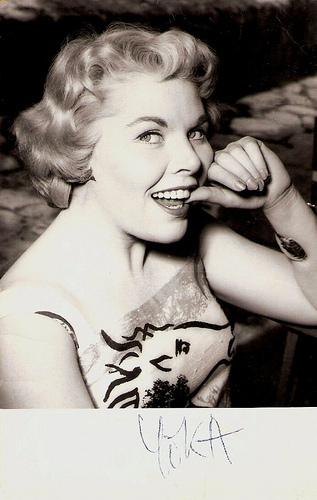
Postcard by Forronia.
Italian films
Yoka Berretty was born as Johanna Ernistina Petrusa Meijeringh in Rotterdam, The Netherlands, in 1928.
After secondary school, she attended acting classes at the Actor's Studio in New York, at the Théatre de Poche with Marcel Marceau and Etienne Decroux in Paris, and in Rome.
Yoka started her career with bit and supporting parts in the Italian films Angela (Edoardo Anton, Dennis O’Keefe, 1955) featuring Mara Lane , the hit Pane, amore e.../Scandal in Sorrento (Dino Risi, 1955) starring Vittorio de Sica and Sophia Loren , the hilarious farce La banda degli onesti/The Band of Honest Men (Camillo Mastrocinque, 1956) starring the comedians Totò and Peppino De Filippo , and the drama Gli occhi senza luce/The Eyes Without Light (Flavio Calzavara, 1956) with Milly Vitale .
She returned to The Netherlands, where she worked on stage for theatre companies like Nederlandse Comedie, Ensemble, Centrum, Amsterdams Volkstoneel and Theaterunie. She also appeared on radio and television.
Incidentally, Berretty played small roles in international film productions such as the war drama The Last Blitzkrieg (Arthur Dreifuss, 1959) starring Van Johnson and the Knut Hamsun adaptation Das Letzte Kapitel/The Last Chapter (Wolfgang Liebeneiner, 1961) with Hansjörg Felmy .
Yoka Berretty as Erica in a hilarious scene from Pane, amore e.../Scandal in Sorrento (Dino Risi, 1955) starring Vittorio de Sica and Sophia Loren . Source: Rosanna Molignini Brockstedt (YouTube).
Yoka sings Een op de valreep (one for the road) in 1960. Recognize the picture? Source: Disco82 (YouTube).
TV Personality
Yoka Berretty became a well known TV personality in The Netherlands. In 1959, she was the organizer and co-presenter of the first TV benefit action show Redt een Kind/Save A Child for child refugees from Algeria. A national sensation was the satiric TV show Zo is het toevallig ook nog eens een keer (1963-1966), based on the BBC programme That Was the Week That Was.
She also played parts in the prestigious Dutch films Makkers staakt uw wild geraas/That Joyous Eve (Fons Rademakers, 1960) as the wife of Guus Oster, and opposite Rob de Vries in De Overval/The Silent Raid (Paul Rotha, 1962) about the Dutch resistance in the Second World War.
Her later films were VD (Wim Verstappen, 1972) with Kees Brusse, Rufus (Samuel Meyering, 1975) starring Rijk de Gooyer , the German-Dutch coproduction Charlotte (Frans Weisz, 1981) starring Birgit Doll and Derek Jacobi, the thriller De Prooi/The Prey (Vivian Pieters, 1985) and Advocaat van de Hanen/Punk Lawyer (Gerrit van Elst, 1996) with Pierre Bokma.
In the 1990s, Berretty played leading parts in three films by director and publicist Theo van Gogh, who was assasinated in 2004: Eva (1992), Au!/Ouch! (1997) and In het belang van de staat/In the Interests of the State (1997) starring Marlies Heuer.
The last times she appeared for the cameras was on television in the popular crime series Baantjer (2000), and in the short film Anderland (2003).
Yoka Berretty was married twice. Her first marriage was with Dominique Berretty, a famed Magnum-photographer whose surname she adopted. Later she was married to publisher Andreas Landshoff, the son of German film actress Ruth Hellberg . Yoka Berretty is the mother of Yolante Berretty, and of director Benjamin Landshoff, in whose TV series Erwassus/Once upon a time (1997), she appeared.
Last week Yoka Berretty made a fall from a staircase in her house in Amsterdam, and on 28 November 2015, she died in a hospital from complications. Her daughter declared that her mother had lead "a beautiful, intense and full life."
De Overval/The Silent Raid (Paul Rotha, 1962). Full movie, no subtitles. Source: kitekat112 (YouTube).
Yoka Berretty sings the title song of the satiric TV programme Zo is het toevallig ook nog eens een keer (1963-1966). Source: Toenwaskwaliteit nogheelgewoon (YouTube).
Source: Beeld en Geluid Wiki (Dutch), Wikipedia (Dutch), Trouw (Dutch), NOS (Dutch) and .

Postcard by Forronia.
Italian films
Yoka Berretty was born as Johanna Ernistina Petrusa Meijeringh in Rotterdam, The Netherlands, in 1928.
After secondary school, she attended acting classes at the Actor's Studio in New York, at the Théatre de Poche with Marcel Marceau and Etienne Decroux in Paris, and in Rome.
Yoka started her career with bit and supporting parts in the Italian films Angela (Edoardo Anton, Dennis O’Keefe, 1955) featuring Mara Lane , the hit Pane, amore e.../Scandal in Sorrento (Dino Risi, 1955) starring Vittorio de Sica and Sophia Loren , the hilarious farce La banda degli onesti/The Band of Honest Men (Camillo Mastrocinque, 1956) starring the comedians Totò and Peppino De Filippo , and the drama Gli occhi senza luce/The Eyes Without Light (Flavio Calzavara, 1956) with Milly Vitale .
She returned to The Netherlands, where she worked on stage for theatre companies like Nederlandse Comedie, Ensemble, Centrum, Amsterdams Volkstoneel and Theaterunie. She also appeared on radio and television.
Incidentally, Berretty played small roles in international film productions such as the war drama The Last Blitzkrieg (Arthur Dreifuss, 1959) starring Van Johnson and the Knut Hamsun adaptation Das Letzte Kapitel/The Last Chapter (Wolfgang Liebeneiner, 1961) with Hansjörg Felmy .
Yoka Berretty as Erica in a hilarious scene from Pane, amore e.../Scandal in Sorrento (Dino Risi, 1955) starring Vittorio de Sica and Sophia Loren . Source: Rosanna Molignini Brockstedt (YouTube).
Yoka sings Een op de valreep (one for the road) in 1960. Recognize the picture? Source: Disco82 (YouTube).
TV Personality
Yoka Berretty became a well known TV personality in The Netherlands. In 1959, she was the organizer and co-presenter of the first TV benefit action show Redt een Kind/Save A Child for child refugees from Algeria. A national sensation was the satiric TV show Zo is het toevallig ook nog eens een keer (1963-1966), based on the BBC programme That Was the Week That Was.
She also played parts in the prestigious Dutch films Makkers staakt uw wild geraas/That Joyous Eve (Fons Rademakers, 1960) as the wife of Guus Oster, and opposite Rob de Vries in De Overval/The Silent Raid (Paul Rotha, 1962) about the Dutch resistance in the Second World War.
Her later films were VD (Wim Verstappen, 1972) with Kees Brusse, Rufus (Samuel Meyering, 1975) starring Rijk de Gooyer , the German-Dutch coproduction Charlotte (Frans Weisz, 1981) starring Birgit Doll and Derek Jacobi, the thriller De Prooi/The Prey (Vivian Pieters, 1985) and Advocaat van de Hanen/Punk Lawyer (Gerrit van Elst, 1996) with Pierre Bokma.
In the 1990s, Berretty played leading parts in three films by director and publicist Theo van Gogh, who was assasinated in 2004: Eva (1992), Au!/Ouch! (1997) and In het belang van de staat/In the Interests of the State (1997) starring Marlies Heuer.
The last times she appeared for the cameras was on television in the popular crime series Baantjer (2000), and in the short film Anderland (2003).
Yoka Berretty was married twice. Her first marriage was with Dominique Berretty, a famed Magnum-photographer whose surname she adopted. Later she was married to publisher Andreas Landshoff, the son of German film actress Ruth Hellberg . Yoka Berretty is the mother of Yolante Berretty, and of director Benjamin Landshoff, in whose TV series Erwassus/Once upon a time (1997), she appeared.
Last week Yoka Berretty made a fall from a staircase in her house in Amsterdam, and on 28 November 2015, she died in a hospital from complications. Her daughter declared that her mother had lead "a beautiful, intense and full life."
De Overval/The Silent Raid (Paul Rotha, 1962). Full movie, no subtitles. Source: kitekat112 (YouTube).
Yoka Berretty sings the title song of the satiric TV programme Zo is het toevallig ook nog eens een keer (1963-1966). Source: Toenwaskwaliteit nogheelgewoon (YouTube).
Source: Beeld en Geluid Wiki (Dutch), Wikipedia (Dutch), Trouw (Dutch), NOS (Dutch) and .
Published on November 30, 2015 10:00
November 29, 2015
Faust (1926)
Recently my good friend and mentor gerda mentink (1941-2015), formerly the cultural motor of the Goethe-Institut Amsterdam, suddenly died. In loving memory of her, I share these beautiful postcards of the silent classic Faust (F.W. Murnau, 1926) with you. Together with gerda, I made an exhibition on Murnau for the Nederlands Filmmuseum (now Eye Film Institute) in 1990. For the poster we used an image of Faust. gerda, rest in peace.
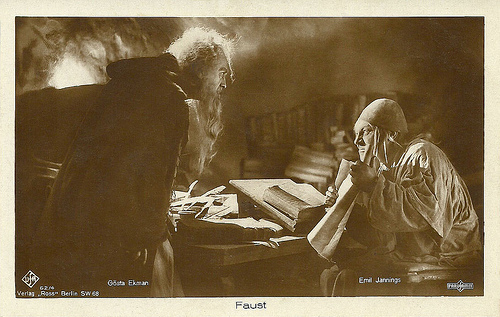
German postcard by Ross Verlag, no. 62/4. Photo: ParUfaMet / Ufa. Still with Gösta Ekman and Emil Jannings in Faust (1926). Collection: Didier Hanson.
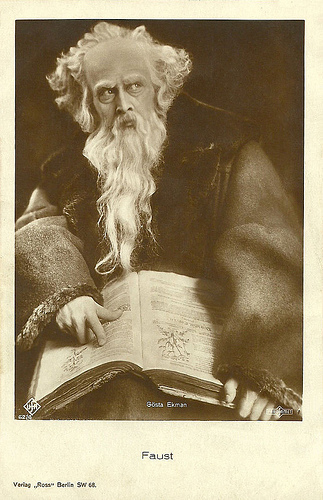
German postcard by Ross Verlag, no. 62/6. Photo: ParUfaMet / Ufa. Still with Gösta Ekman in Faust (1926). Collection: Didier Hanson.
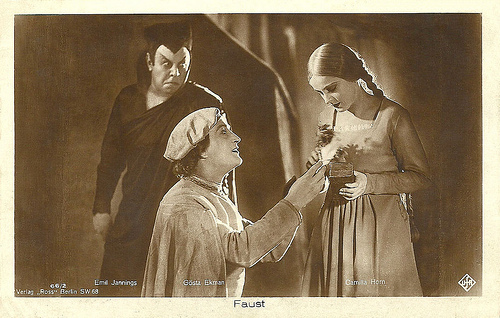
German postcard by Ross Verlag, no. 66/2. Photo: Ufa. Still with Gösta Ekman , Emil Jannings and Camilla Horn in Faust (1926). Collection: Didier Hanson.
A Dizzying Trip
Faust – Eine deutsche Volkssage/Faust (1926) still is one of my favourite films. It is an overwhelming spectacle of unparalleled camera work and beautiful scenery.
Faust is one of the highlights of the silent European cinema and the last in a series of classics directed by Friedrich Wilhelm Murnau for the Ufa studios in Babelsberg.
In 1926, Faust was the most expensive European film ever. Filming took six months and a cost of 2 million. You can see why, there are many spectacular scenes.
Wonderful is the scene where Mephisto takes Faust flying along on his magic cloak for a dizzying trip. In an enchanting, seemingly endless camera movement we follow Mephisto and his victim over nocturnal landscapes, narrowly skimming along spiers and peaks. This kind of prospects were never seen before in the cinema.
Faust showed what was possible in the Ufa studios in Babelsberg. The set was built in a studio of 20 by 35 meters. The camera was added with a motor as a sort of rail-roller coaster. The scenery and camera movement give us the feeling that the camera flies.
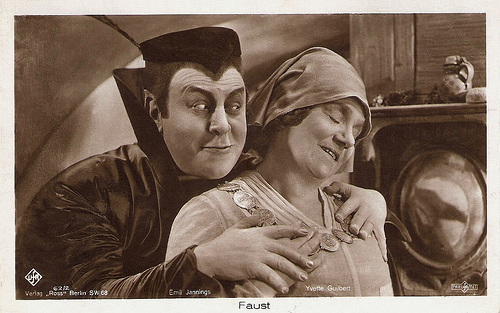
German postcard by Ross Verlag, no. 62/2. Photo: ParUfaMet / Ufa. Still with Emil Jannings as Mephisto and Yvette Guilbert as Marthe in Faust (1926).
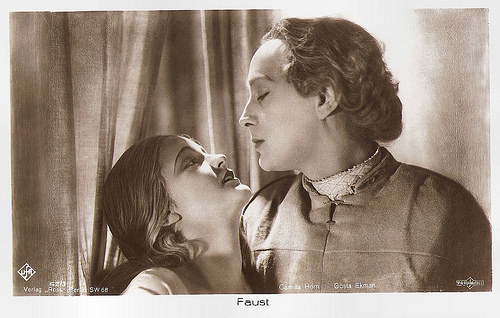
German postcard by Ross Verlag, no. 62/3. Photo: Ufa. Publicity still for Faust (Friedrich Wilhelm Murnau, 1926) with Camilla Horn and Gösta Ekman.
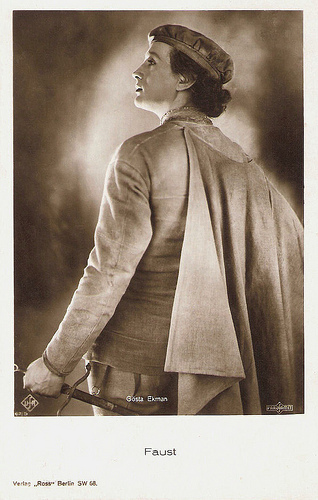
German postcard by Ross Verlag, no. 62/5. Photo: ParUfaMet / Ufa. Still with Gösta Ekman as the young Faust in Faust (1926).
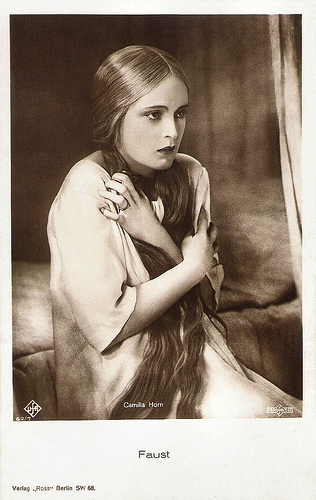
German postcard by Ross Verlag, no. 62/7. Photo: Ufa. Publicity still for Faust (Friedrich Wilhelm Murnau, 1926) with Camilla Horn .
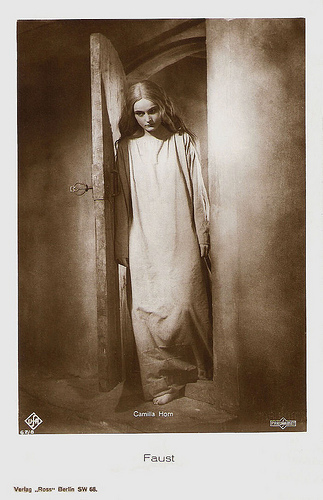
German postcard by Ross Verlag, no. 62/8. Photo: ParUfaMet / Ufa. Still with Camilla Horn as Gretchen for Faust (1926).
Evil Tempter
The title figure Faust is played by the Swedish star Gösta Ekman . With his boyish good looks, Ekman was able to captivate his audiences, of both sexes.
The innocent girl Gretchen was played by a young and inexperienced dancer, the ethereally blonde Camilla Horn . Her film debut would be the start of a long and impressive career.
Gretchen’s aunt Marthe was portrayed by the legendary French actress Yvette Guilbert.
And then there was Emil Jannings , who had worked with Murnau before at Der Letzte Mann/The Last Laugh (F. W. Murnau, 1924) and at Herr Tartüff/Tartuffe (F.W. Murnau, 1925). He now played the plum role of the demon Mephistoteles. Jannings is hilarious as the evil tempter and draws all attention to himself.
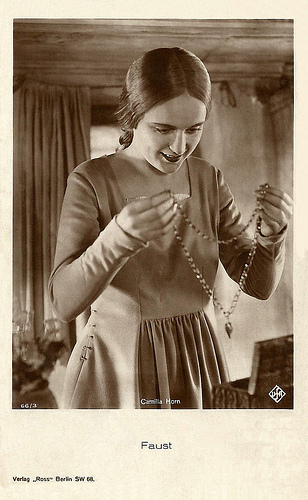
German postcard by Ross Verlag, no. 66/3. Photo: ParUfaMet / Ufa. Still with Camilla Horn as Gretchen for Faust (1926).
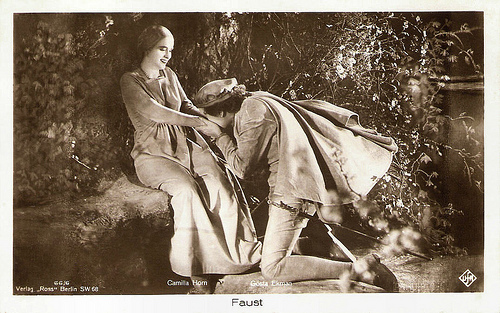
German postcard by Ross Verlag, no. 66/6. Photo: Ufa. Publicity still for Faust (1926) with Camilla Horn and Gösta Ekman.
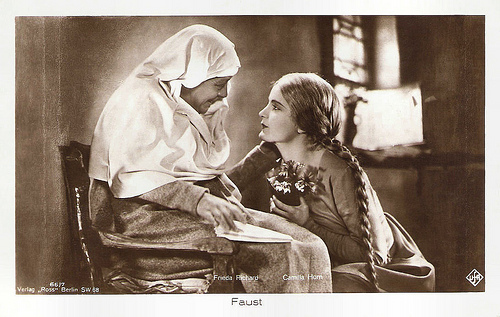
German postcard by Ross Verlag, no. 66/7. Photo: Ufa. Publicity still for Faust (Friedrich Wilhelm Murnau, 1926) with Camilla Horn and Frieda Richard.
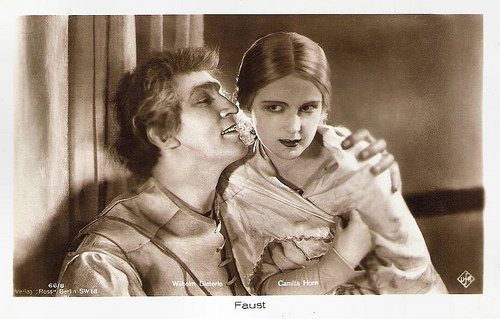
German postcard by Ross Verlag, no. 66/8. Photo: Ufa. Publicity still for Faust (1926) with Wilhelm Dieterle and Camilla Horn .
Light and Dark
The theme of the film is the struggle between light and dark. Faust opens with a prologue in heaven with the metaphysical battle between the devil and the archangel.
We see a blinding entanglement of light and dark areas that try to push each other away. Mephisto has a bet with the archangel that he can corrupt an honest man's soul and destroy in him what is divine.
Later the demon wraps the town with his dark cloak. He sends black smoke into the streets and thus poisons the inhabitants with the plague.
The old and learned alchemist Faust can’t do anything against the misery of the plague. Deeply disappointed, he sells his soul to Mephisto to relive his youth. Mephisto loads Faust with power and wealth, but despite this all he fails to destroy the divine in Faust’s soul.
Faust’s love for Gretchen triumphs over all. The film ends with the rotating beams of the sun that link to hope and redemption.
Restored Deluxe Edition DVD Trailer of Faust (1926). Source: Kino International (YouTube).
The magic carpet ride from Faust, scored at Dartington International Summer Festival. Source: Andrew Fingers (YouTube).
Sources: Wikipedia and IMDb.

German postcard by Ross Verlag, no. 62/4. Photo: ParUfaMet / Ufa. Still with Gösta Ekman and Emil Jannings in Faust (1926). Collection: Didier Hanson.

German postcard by Ross Verlag, no. 62/6. Photo: ParUfaMet / Ufa. Still with Gösta Ekman in Faust (1926). Collection: Didier Hanson.

German postcard by Ross Verlag, no. 66/2. Photo: Ufa. Still with Gösta Ekman , Emil Jannings and Camilla Horn in Faust (1926). Collection: Didier Hanson.
A Dizzying Trip
Faust – Eine deutsche Volkssage/Faust (1926) still is one of my favourite films. It is an overwhelming spectacle of unparalleled camera work and beautiful scenery.
Faust is one of the highlights of the silent European cinema and the last in a series of classics directed by Friedrich Wilhelm Murnau for the Ufa studios in Babelsberg.
In 1926, Faust was the most expensive European film ever. Filming took six months and a cost of 2 million. You can see why, there are many spectacular scenes.
Wonderful is the scene where Mephisto takes Faust flying along on his magic cloak for a dizzying trip. In an enchanting, seemingly endless camera movement we follow Mephisto and his victim over nocturnal landscapes, narrowly skimming along spiers and peaks. This kind of prospects were never seen before in the cinema.
Faust showed what was possible in the Ufa studios in Babelsberg. The set was built in a studio of 20 by 35 meters. The camera was added with a motor as a sort of rail-roller coaster. The scenery and camera movement give us the feeling that the camera flies.

German postcard by Ross Verlag, no. 62/2. Photo: ParUfaMet / Ufa. Still with Emil Jannings as Mephisto and Yvette Guilbert as Marthe in Faust (1926).

German postcard by Ross Verlag, no. 62/3. Photo: Ufa. Publicity still for Faust (Friedrich Wilhelm Murnau, 1926) with Camilla Horn and Gösta Ekman.

German postcard by Ross Verlag, no. 62/5. Photo: ParUfaMet / Ufa. Still with Gösta Ekman as the young Faust in Faust (1926).

German postcard by Ross Verlag, no. 62/7. Photo: Ufa. Publicity still for Faust (Friedrich Wilhelm Murnau, 1926) with Camilla Horn .

German postcard by Ross Verlag, no. 62/8. Photo: ParUfaMet / Ufa. Still with Camilla Horn as Gretchen for Faust (1926).
Evil Tempter
The title figure Faust is played by the Swedish star Gösta Ekman . With his boyish good looks, Ekman was able to captivate his audiences, of both sexes.
The innocent girl Gretchen was played by a young and inexperienced dancer, the ethereally blonde Camilla Horn . Her film debut would be the start of a long and impressive career.
Gretchen’s aunt Marthe was portrayed by the legendary French actress Yvette Guilbert.
And then there was Emil Jannings , who had worked with Murnau before at Der Letzte Mann/The Last Laugh (F. W. Murnau, 1924) and at Herr Tartüff/Tartuffe (F.W. Murnau, 1925). He now played the plum role of the demon Mephistoteles. Jannings is hilarious as the evil tempter and draws all attention to himself.

German postcard by Ross Verlag, no. 66/3. Photo: ParUfaMet / Ufa. Still with Camilla Horn as Gretchen for Faust (1926).

German postcard by Ross Verlag, no. 66/6. Photo: Ufa. Publicity still for Faust (1926) with Camilla Horn and Gösta Ekman.

German postcard by Ross Verlag, no. 66/7. Photo: Ufa. Publicity still for Faust (Friedrich Wilhelm Murnau, 1926) with Camilla Horn and Frieda Richard.

German postcard by Ross Verlag, no. 66/8. Photo: Ufa. Publicity still for Faust (1926) with Wilhelm Dieterle and Camilla Horn .
Light and Dark
The theme of the film is the struggle between light and dark. Faust opens with a prologue in heaven with the metaphysical battle between the devil and the archangel.
We see a blinding entanglement of light and dark areas that try to push each other away. Mephisto has a bet with the archangel that he can corrupt an honest man's soul and destroy in him what is divine.
Later the demon wraps the town with his dark cloak. He sends black smoke into the streets and thus poisons the inhabitants with the plague.
The old and learned alchemist Faust can’t do anything against the misery of the plague. Deeply disappointed, he sells his soul to Mephisto to relive his youth. Mephisto loads Faust with power and wealth, but despite this all he fails to destroy the divine in Faust’s soul.
Faust’s love for Gretchen triumphs over all. The film ends with the rotating beams of the sun that link to hope and redemption.
Restored Deluxe Edition DVD Trailer of Faust (1926). Source: Kino International (YouTube).
The magic carpet ride from Faust, scored at Dartington International Summer Festival. Source: Andrew Fingers (YouTube).
Sources: Wikipedia and IMDb.
Published on November 29, 2015 22:00
November 28, 2015
Ève Francis
Belgian born actress Ève Francis (1886-1980) was the star of the French impressionist cinema, in particular of the films by Germaine Dulac and Louis Delluc. Less known is that she was an active assistant director too.
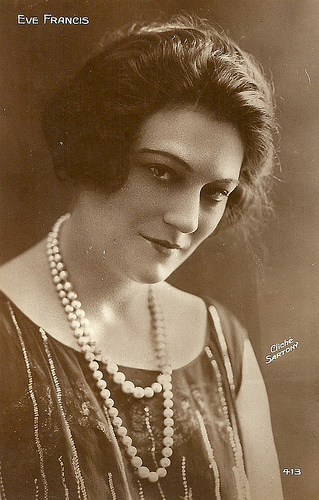
French postcard, no. 413. Photo: Sartony.
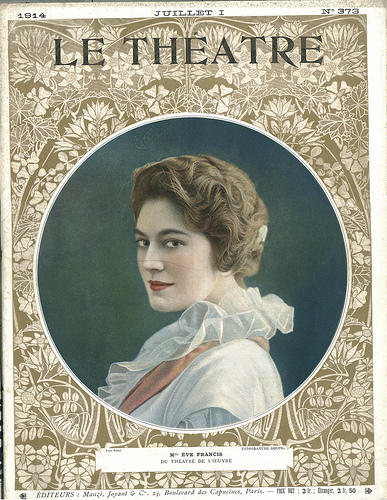
Cover of the magazine Le Théâtre, no. 373, 1914. Collection: Manuel Palomino Arjona @ Flickr.
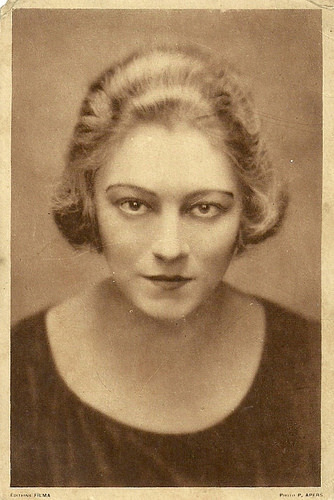
French postcard by Ed. Filma. Photo: P. Apers.
Germaine Dulac and Louis Delluc
Ève Francis was born Eva Louise François in St. Josse-ten-Noode, Belgium in 1886. After completing her secondary education in Belgium, she embarked on a career as an actress and began working in the theatre in Paris in 1913.
The following year she was introduced to the author Paul Claudel who chose her for the leading role in the first Paris production of his play L'Otage (The Hostage). Although only a few performances were given, the play was well-received in literary and artistic circles and her reputation was established. She became for a long period Claudel's muse and interpreter, and in later years she described him as the most extraordinary person she had known and the dominant influence in her life.
In 1914 she also made her film début in the silent short La dame blonde/The Blonde Lady (Charles Maudru, 1914) with Henry Roussel. Roussel next directed her in his own film Un homme passa/A Man Passed (Henry Roussel, 1916).
In 1917 Francis played in Le roi de la mer/The King of the Sea (Jacques de Baroncelli, 1917), but she also appeared in her first film with female film director Germaine Dulac: Ames de fous/Fools' Hearts (1917). Dulac apparently liked Francis, as she gave Francis leading roles in Le bonheur des autres/The Happiness of Others (Germaine Dulac, 1918) and La fête espagnole/Spanish Fiesta (Germaine Dulac, 1920).
Francis had one of her greatest successes in Marcel L'Herbier's El Dorado (1921) in which she played the ill-fated cabaret dancer Sibilla opposite Jaque Catelain . Francis became the epitomized actress of the French art film scene. She only played in the so-called Impressionist French silent films by Dulac, L'Herbier and later by Louis Delluc.
Francis had met the young novelist, poet and playwright Delluc during the war. She had introduced him to the American cinema in 1916, and Delluc was smitten. He became an innovating film critic and later a prominent film director. They married in 1918. In the next five years Delluc shot seven films, all with his wife. Two of these films remain among the immortal masterpieces of the French cinema: Fièvre/Fever (Louis Delluc, 1921) and La Femme de nulle part/The Woman from Nowhere (Louis Delluc, 1922).
Gilles Delluc writes at Les Indépendants du premier siècle : "True films, shot in natural surroundings, without gesticulations and spectacular events. The characters are shown in an impressionnistic way, intimist, often with a correlation between past and present, dream and reality. All this was a revolutionnary for the time."
Louis Delluc's last film, L'Inondation/The Flood (1923) was shot in the Rhone valley. The weather was cold and rainy, and Delluc developed a severe case of galloping consumption. He died at 33, in the span of a few weeks.
After this tragedy, Francis returned to Dulac in 1924 for Ame’d’artiste/Heart of an Actress (Germaine Dulac, 1924) starring Ivan Petrovich and Nicolas Koline , followed by Antoinette Sabatier (Germaine Dulac, 1926).
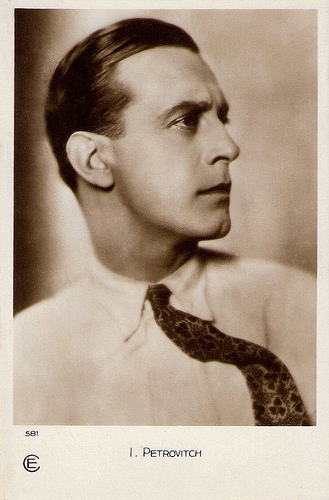
Ivan Petrovich . French postcard by Cinémagazine-Edition, Paris, no. 581.
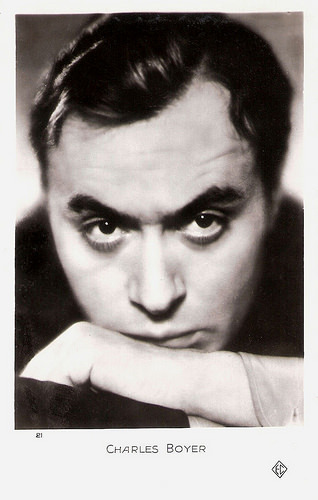
Charles Boyer . French postcard by EC (Editions Chantal), Paris, no. 21.
Marcel L'Herbier and Paul Claudel
After her role in Antoinette Sabatier, Ève Francis did not appear in films anymore for years. When she returned in the sound era, it was foremost as assistant-director of Marcel L’Herbier. He had been another representant of the Impressionist cinema in the 1920s, but he was now working in a more conventional style.
Francis assisted Marcel L’Herbier with eleven films, including L’épervier/The Casting Net (1933) starring a young and very handsome Charles Boyer , Le scandale/The Scandal (1933) with Gaby Morlay , Le bonheur/Happiness (1934), La route impériale/The Imperial Road (1935) with Käthe von Nagy , Veille d’armes/Sacrifice of Honour (1935) with Annabella , La porte du large/The Great Temptation (1936) with Victor Francen , La citadelle du silence/The Citadel of Silence (1937) with Annabella , and La brigade sauvage/Savage Brigade (1939) with Charles Vanel .
Francis did also act in Club de femmes/Women's Club (Jacques Deval, 1936), Forfaiture/The Cheat (Marcel L'Herbier, 1937) with Sessue Hayakawa , La mode revée/The Ideal fashion (Marcel L'Herbier, 1939) with Gaby Morlay , La brigade sauvage/Savage Brigade (Marcel L'Herbier, 1939), La comédie du bonheur/Comedy of Happiness (Marcel L'Herbier, 1940), and the Italian version of the latter: Ecco la felicità/Here Comes Happiness (Marcel L'Herbier, 1940) both starring Michel Simon and Ramon Novarro.
In the postwar era, Francis gave support to the growing network of film societies in France (ciné-clubs), a project which Louis Delluc had first promulgated in 1920. She also did some television work in the late 1960s. She published two books: Temps héroïques: théâtre, cinéma (Heroic Times: Theater, Cinema) (1949), with a preface by Paul Claudel and her portrait of Louis Delluc. She recorded her recollections of Claudel himself in Un autre Claudel (Another Claudel) (1973).
In her late eighties, she had two final film roles in La chair de l’orchidée/Flesh of the Orchid (Patrice Chéreau, 1974) starring Charlotte Rampling , and Adieu, poulet/The French Detective (Pierre Granier-Deferre, 1975) with Lino Ventura .
Ève Francis died in 1980 in Neuilly-sur-Seine, France, at the age of 94.
Elements of the stage production of L'homme à la rose (1921) by Henry Bataille. Source: ben77114gaut (YouTube).
Excerpts from El Dorado (1921). Source: Iconauta (YouTube).
Fièvre/Fever (Louis Delluc, 1921). Source: Cinema History (YouTube).
Sources: Gilles Delluc (Les Indépendants du Premier Siècle), Daniel Chocron (CineArtistes.com - French), Wikipedia and .

French postcard, no. 413. Photo: Sartony.

Cover of the magazine Le Théâtre, no. 373, 1914. Collection: Manuel Palomino Arjona @ Flickr.

French postcard by Ed. Filma. Photo: P. Apers.
Germaine Dulac and Louis Delluc
Ève Francis was born Eva Louise François in St. Josse-ten-Noode, Belgium in 1886. After completing her secondary education in Belgium, she embarked on a career as an actress and began working in the theatre in Paris in 1913.
The following year she was introduced to the author Paul Claudel who chose her for the leading role in the first Paris production of his play L'Otage (The Hostage). Although only a few performances were given, the play was well-received in literary and artistic circles and her reputation was established. She became for a long period Claudel's muse and interpreter, and in later years she described him as the most extraordinary person she had known and the dominant influence in her life.
In 1914 she also made her film début in the silent short La dame blonde/The Blonde Lady (Charles Maudru, 1914) with Henry Roussel. Roussel next directed her in his own film Un homme passa/A Man Passed (Henry Roussel, 1916).
In 1917 Francis played in Le roi de la mer/The King of the Sea (Jacques de Baroncelli, 1917), but she also appeared in her first film with female film director Germaine Dulac: Ames de fous/Fools' Hearts (1917). Dulac apparently liked Francis, as she gave Francis leading roles in Le bonheur des autres/The Happiness of Others (Germaine Dulac, 1918) and La fête espagnole/Spanish Fiesta (Germaine Dulac, 1920).
Francis had one of her greatest successes in Marcel L'Herbier's El Dorado (1921) in which she played the ill-fated cabaret dancer Sibilla opposite Jaque Catelain . Francis became the epitomized actress of the French art film scene. She only played in the so-called Impressionist French silent films by Dulac, L'Herbier and later by Louis Delluc.
Francis had met the young novelist, poet and playwright Delluc during the war. She had introduced him to the American cinema in 1916, and Delluc was smitten. He became an innovating film critic and later a prominent film director. They married in 1918. In the next five years Delluc shot seven films, all with his wife. Two of these films remain among the immortal masterpieces of the French cinema: Fièvre/Fever (Louis Delluc, 1921) and La Femme de nulle part/The Woman from Nowhere (Louis Delluc, 1922).
Gilles Delluc writes at Les Indépendants du premier siècle : "True films, shot in natural surroundings, without gesticulations and spectacular events. The characters are shown in an impressionnistic way, intimist, often with a correlation between past and present, dream and reality. All this was a revolutionnary for the time."
Louis Delluc's last film, L'Inondation/The Flood (1923) was shot in the Rhone valley. The weather was cold and rainy, and Delluc developed a severe case of galloping consumption. He died at 33, in the span of a few weeks.
After this tragedy, Francis returned to Dulac in 1924 for Ame’d’artiste/Heart of an Actress (Germaine Dulac, 1924) starring Ivan Petrovich and Nicolas Koline , followed by Antoinette Sabatier (Germaine Dulac, 1926).

Ivan Petrovich . French postcard by Cinémagazine-Edition, Paris, no. 581.

Charles Boyer . French postcard by EC (Editions Chantal), Paris, no. 21.
Marcel L'Herbier and Paul Claudel
After her role in Antoinette Sabatier, Ève Francis did not appear in films anymore for years. When she returned in the sound era, it was foremost as assistant-director of Marcel L’Herbier. He had been another representant of the Impressionist cinema in the 1920s, but he was now working in a more conventional style.
Francis assisted Marcel L’Herbier with eleven films, including L’épervier/The Casting Net (1933) starring a young and very handsome Charles Boyer , Le scandale/The Scandal (1933) with Gaby Morlay , Le bonheur/Happiness (1934), La route impériale/The Imperial Road (1935) with Käthe von Nagy , Veille d’armes/Sacrifice of Honour (1935) with Annabella , La porte du large/The Great Temptation (1936) with Victor Francen , La citadelle du silence/The Citadel of Silence (1937) with Annabella , and La brigade sauvage/Savage Brigade (1939) with Charles Vanel .
Francis did also act in Club de femmes/Women's Club (Jacques Deval, 1936), Forfaiture/The Cheat (Marcel L'Herbier, 1937) with Sessue Hayakawa , La mode revée/The Ideal fashion (Marcel L'Herbier, 1939) with Gaby Morlay , La brigade sauvage/Savage Brigade (Marcel L'Herbier, 1939), La comédie du bonheur/Comedy of Happiness (Marcel L'Herbier, 1940), and the Italian version of the latter: Ecco la felicità/Here Comes Happiness (Marcel L'Herbier, 1940) both starring Michel Simon and Ramon Novarro.
In the postwar era, Francis gave support to the growing network of film societies in France (ciné-clubs), a project which Louis Delluc had first promulgated in 1920. She also did some television work in the late 1960s. She published two books: Temps héroïques: théâtre, cinéma (Heroic Times: Theater, Cinema) (1949), with a preface by Paul Claudel and her portrait of Louis Delluc. She recorded her recollections of Claudel himself in Un autre Claudel (Another Claudel) (1973).
In her late eighties, she had two final film roles in La chair de l’orchidée/Flesh of the Orchid (Patrice Chéreau, 1974) starring Charlotte Rampling , and Adieu, poulet/The French Detective (Pierre Granier-Deferre, 1975) with Lino Ventura .
Ève Francis died in 1980 in Neuilly-sur-Seine, France, at the age of 94.
Elements of the stage production of L'homme à la rose (1921) by Henry Bataille. Source: ben77114gaut (YouTube).
Excerpts from El Dorado (1921). Source: Iconauta (YouTube).
Fièvre/Fever (Louis Delluc, 1921). Source: Cinema History (YouTube).
Sources: Gilles Delluc (Les Indépendants du Premier Siècle), Daniel Chocron (CineArtistes.com - French), Wikipedia and .
Published on November 28, 2015 22:00
November 27, 2015
Imported from the USA: Betty Amann
Dark-haired German-American actress Betty Amann (1905-1990) started her film career in Hollywood, but director Joe May and producer Erich Pommer discovered her for the German cinema. Her typical role was the immoral and alluring femme fatale who seduces and corrupts men.
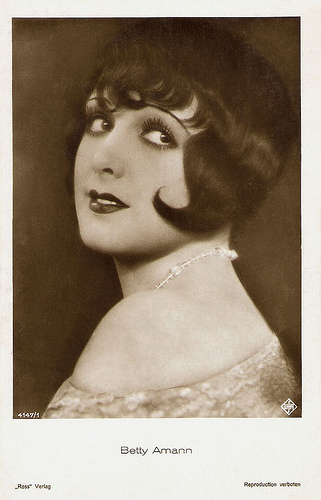
German postcard by Ross Verlag, no. 4147/1, 1929-1930. Photo: Ufa.
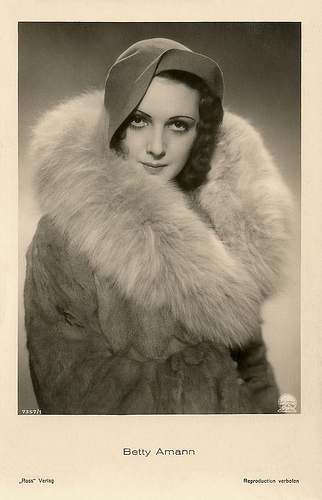
German postcard by Ross Verlag, no. 7357/1, 1932-1933. Photo: Paramount.
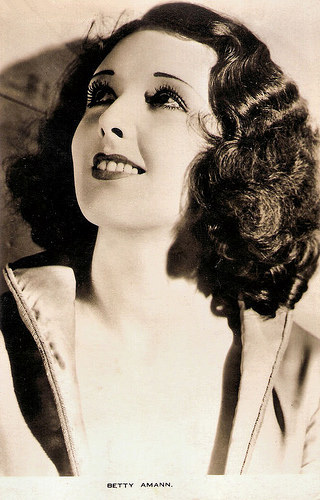
British postcard.
The Kick-off
Betty Amann was born Philippine Amann in Pirmasens, Germany, in 1905. Together with her German-American parents, she moved to the United States at an early age.
By her own account, she studied painting at the National Academy School of Fine Arts in New York before she was discovered for the stage and won small parts at the May Palace Theater.
She started her film career with the romantic movie The Kick-off (Wesley Ruggles, 1926). Under the nickname Bee Amann, she starred as a farmer's daughter opposite Tom Tyler in the western Trail of the Horse Thieves (Robert De Lacey, 1929) for the low-budget studio Film Booking Offices of America (FBO).
She returned to Germany and arrived in Berlin in the wake of Louise Brooks . Director Joe May and Ufa-producer Erich Pommer gave her a screentest, and then offered her a leading role in Asphalt (Joe May, 1929). In this masterpiece of the German silent cinema she played a femme fatale thief who corrupts true-blue policeman Gustav Fröhlich . It was Pommer who gave her the pseudonym Betty.
In her next film, Der Sträfling aus Stambul/The Convict From Stambul (Gustav Ucicky, 1929), she was the co-star of Heinrich George and Paul Hörbiger . Soon, more films followed.
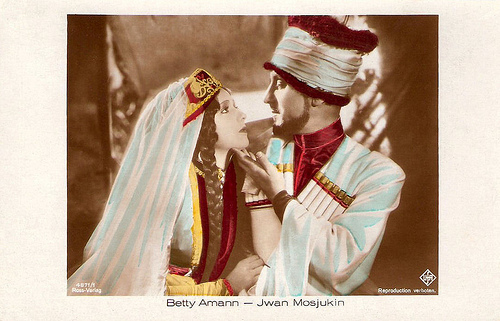
German postcard by Ross Verlag, no. 4871/1, 1929-1930 with Ivan Mozzhukhin . Photo: Ufa.
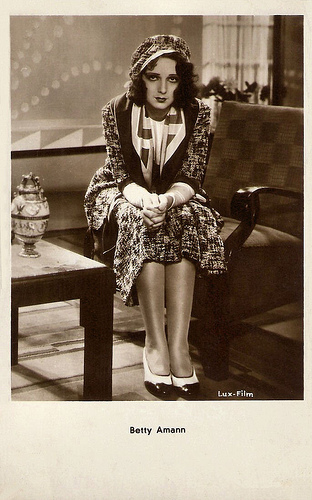
Austrian postcard by Iris Verlag, no. 6016. Photo: Lux-Film.
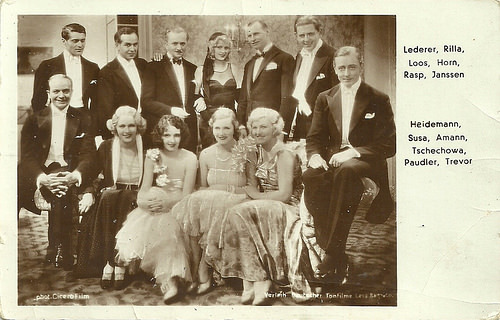
German postcard. Photo: Cicero Film / Distribution Deutsche Tonfilme. The 'fine fleur' of late silent German cinema stars, united for a photo for an early sound film company. Standing left to right: Francis/Franz Lederer, Walter Rilla, Theodor Loos, Camilla Horn, Fritz Rasp and Walter Janssen, Sitting left to right: Paul Heidemann, Charlotte Susa, Betty Amann, Olga Tschechowa, Maria Paudler and Jack Trevor. Publicity for the early sound comedy Die grosse Sehnsucht/The Great Longing (Stefan Szekely/Steve Sekely, 1930), in which all acted, mostly as themselves - only Loos and Horn played characters. The plot was an excuse for 35 stars to debut in a talking picture.
Mosjoukine
Betty Amann was the leading lady of the Ufa production Der Weisse Teufel/The White Devil (Alexandre Volkoff, 1929), based on a novel by Leo Tolstoy.
With great style and visual flare Alexandre Volkoff directed this film that represented the European silent tradition at it's finest and most dynamic. Russian émigré Ivan Mozzhukhin , the great star of the French silent cinema aka ‘Mosjoukine’, features as a fiery Caucasian captain Hadscht Murat.
Der Weisse Teufel was his first film to include a synchronised soundtrack: existing of an effective score by Michael Lewin and others, some sequences of singing and whistling, and a range of sound effects, but no dialogue.
The later director Michael Powell was apparently the stills photographer on the film and therefore may be the maker of the photo used for the postcard above.
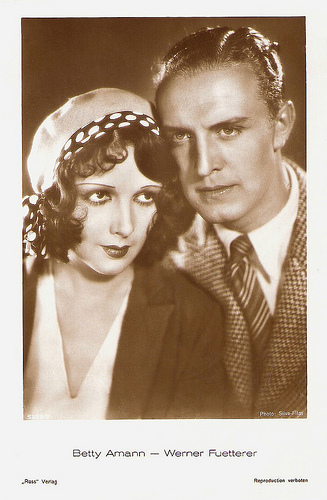
German postcard by Ross Verlag, no. 5325/2, 1930-1931. Photo: Silva-Film. Publicity still for O alte Burschenherrlichkeit/Oh Those Glorious Old Student Days (Rolf Randolf, 1930) with Werner Fuetterer .
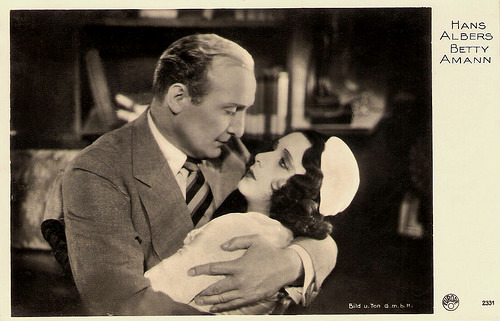
French postcard by Europe, no. 2331. Photo: Bild und Ton GmbH. Publicity still for Hans in allen Gassen/Hans-of-all-trades (Carl Froelich, 1930) with Hans Albers.
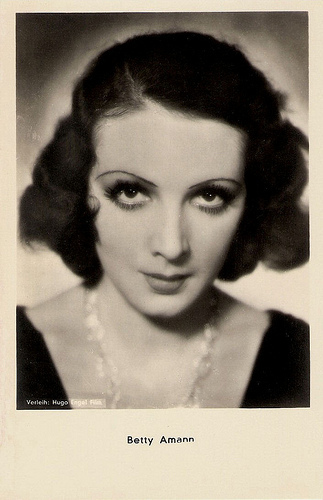
Austrian postcard by Iris Verlag, no. 6782. Photo: Verleih Hugo Engel Film. Still for Der Grosse Bluff/The Big Bluff (Georg Jacoby, 1933).
Rich and Strange
When the sound film arrived Betty Amann kept working in Germany. In the crime film Hans in allen Gassen/Hans in All Alleys (Carl Froelich, 1930), she co-starred with Hans Albers as an alluring stranger who turns out to be a murderess.
From 1931 on she also worked in England. For Alfred Hitchcock she played a trickster in the romantic comedy Rich and Strange (Alfred Hitchcock, 1931). In 1933 she emigrated to Great-Britain.
One of her last roles in a German film was in Schleppzug M 17/Tugboat M 17 ( Heinrich George , Werner Hochbaum, 1933) as a prostitute and thief who seduces a family man.
By 1938, she was married to the lawyer David B. Stillman and took up permanent residence in the United States, where she shot the western In Old Mexico (Edward D. Venturini, 1938) with William Boyd. One year later, she could be seen in Nancy Drew… Reporter (William Clemens, 1939), a movie which was part of the Nancy Drew series starring Bonita Granville.
Her last role was one of Gale Sondergaard's harbour prostitutes in the bizarre treasure hunter movie Isle of Forgotten Sins (Edgar G. Ulmer, 1943).
In 1987 Betty Amann was awarded the Filmband in Gold for her attributions to the German cinema. She died in 1990 in Westport, USA.
A scene from Asphalt (1929). Source: Golden Silents (YouTube).
Another scene from Asphalt (1929). Source: Saskia (YouTube).
A scene from Der Weisse Teufel/The White Devil (1929), including a vintage soundtrack made the same year to fit the film with sound. Source: Golden Silents (YouTube).
Sources: Hans J. Wollstein (AllMovie), Thomas Hamilton (IMDb), Filmportal.de, Wikipedia, and .

German postcard by Ross Verlag, no. 4147/1, 1929-1930. Photo: Ufa.

German postcard by Ross Verlag, no. 7357/1, 1932-1933. Photo: Paramount.

British postcard.
The Kick-off
Betty Amann was born Philippine Amann in Pirmasens, Germany, in 1905. Together with her German-American parents, she moved to the United States at an early age.
By her own account, she studied painting at the National Academy School of Fine Arts in New York before she was discovered for the stage and won small parts at the May Palace Theater.
She started her film career with the romantic movie The Kick-off (Wesley Ruggles, 1926). Under the nickname Bee Amann, she starred as a farmer's daughter opposite Tom Tyler in the western Trail of the Horse Thieves (Robert De Lacey, 1929) for the low-budget studio Film Booking Offices of America (FBO).
She returned to Germany and arrived in Berlin in the wake of Louise Brooks . Director Joe May and Ufa-producer Erich Pommer gave her a screentest, and then offered her a leading role in Asphalt (Joe May, 1929). In this masterpiece of the German silent cinema she played a femme fatale thief who corrupts true-blue policeman Gustav Fröhlich . It was Pommer who gave her the pseudonym Betty.
In her next film, Der Sträfling aus Stambul/The Convict From Stambul (Gustav Ucicky, 1929), she was the co-star of Heinrich George and Paul Hörbiger . Soon, more films followed.

German postcard by Ross Verlag, no. 4871/1, 1929-1930 with Ivan Mozzhukhin . Photo: Ufa.

Austrian postcard by Iris Verlag, no. 6016. Photo: Lux-Film.

German postcard. Photo: Cicero Film / Distribution Deutsche Tonfilme. The 'fine fleur' of late silent German cinema stars, united for a photo for an early sound film company. Standing left to right: Francis/Franz Lederer, Walter Rilla, Theodor Loos, Camilla Horn, Fritz Rasp and Walter Janssen, Sitting left to right: Paul Heidemann, Charlotte Susa, Betty Amann, Olga Tschechowa, Maria Paudler and Jack Trevor. Publicity for the early sound comedy Die grosse Sehnsucht/The Great Longing (Stefan Szekely/Steve Sekely, 1930), in which all acted, mostly as themselves - only Loos and Horn played characters. The plot was an excuse for 35 stars to debut in a talking picture.
Mosjoukine
Betty Amann was the leading lady of the Ufa production Der Weisse Teufel/The White Devil (Alexandre Volkoff, 1929), based on a novel by Leo Tolstoy.
With great style and visual flare Alexandre Volkoff directed this film that represented the European silent tradition at it's finest and most dynamic. Russian émigré Ivan Mozzhukhin , the great star of the French silent cinema aka ‘Mosjoukine’, features as a fiery Caucasian captain Hadscht Murat.
Der Weisse Teufel was his first film to include a synchronised soundtrack: existing of an effective score by Michael Lewin and others, some sequences of singing and whistling, and a range of sound effects, but no dialogue.
The later director Michael Powell was apparently the stills photographer on the film and therefore may be the maker of the photo used for the postcard above.

German postcard by Ross Verlag, no. 5325/2, 1930-1931. Photo: Silva-Film. Publicity still for O alte Burschenherrlichkeit/Oh Those Glorious Old Student Days (Rolf Randolf, 1930) with Werner Fuetterer .

French postcard by Europe, no. 2331. Photo: Bild und Ton GmbH. Publicity still for Hans in allen Gassen/Hans-of-all-trades (Carl Froelich, 1930) with Hans Albers.

Austrian postcard by Iris Verlag, no. 6782. Photo: Verleih Hugo Engel Film. Still for Der Grosse Bluff/The Big Bluff (Georg Jacoby, 1933).
Rich and Strange
When the sound film arrived Betty Amann kept working in Germany. In the crime film Hans in allen Gassen/Hans in All Alleys (Carl Froelich, 1930), she co-starred with Hans Albers as an alluring stranger who turns out to be a murderess.
From 1931 on she also worked in England. For Alfred Hitchcock she played a trickster in the romantic comedy Rich and Strange (Alfred Hitchcock, 1931). In 1933 she emigrated to Great-Britain.
One of her last roles in a German film was in Schleppzug M 17/Tugboat M 17 ( Heinrich George , Werner Hochbaum, 1933) as a prostitute and thief who seduces a family man.
By 1938, she was married to the lawyer David B. Stillman and took up permanent residence in the United States, where she shot the western In Old Mexico (Edward D. Venturini, 1938) with William Boyd. One year later, she could be seen in Nancy Drew… Reporter (William Clemens, 1939), a movie which was part of the Nancy Drew series starring Bonita Granville.
Her last role was one of Gale Sondergaard's harbour prostitutes in the bizarre treasure hunter movie Isle of Forgotten Sins (Edgar G. Ulmer, 1943).
In 1987 Betty Amann was awarded the Filmband in Gold for her attributions to the German cinema. She died in 1990 in Westport, USA.
A scene from Asphalt (1929). Source: Golden Silents (YouTube).
Another scene from Asphalt (1929). Source: Saskia (YouTube).
A scene from Der Weisse Teufel/The White Devil (1929), including a vintage soundtrack made the same year to fit the film with sound. Source: Golden Silents (YouTube).
Sources: Hans J. Wollstein (AllMovie), Thomas Hamilton (IMDb), Filmportal.de, Wikipedia, and .
Published on November 27, 2015 22:00
November 26, 2015
EFSP's Dazzling Dozen: The Lubitsch Touch
German-American director Ernst Lubitsch (1892-1947) had the reputation of being Hollywood's most elegant and sophisticated director. His films were promoted as having ‘the Lubitsch touch.’ In the 1910s, he had started out as an actor and director in the silent cinema of the Weimar republic. In Berlin, he made his first masterpieces with stars like Ossi Oswalda, Henny Porten and Pola Negri. Today on EFSP, twelve dazzling postcards with the Lubitsch Touch.
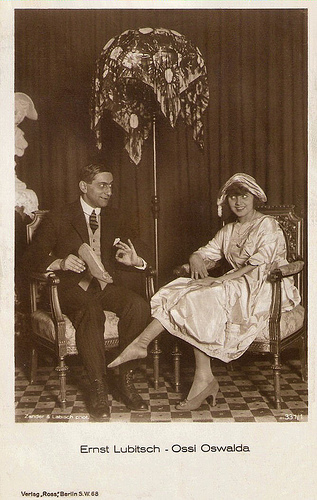
Ernst Lubitsch and Ossi Oswalda . German postcard by Ross Verlag, Berlin, no. 337/1, 1919-1924. Photo: Zander & Labisch.
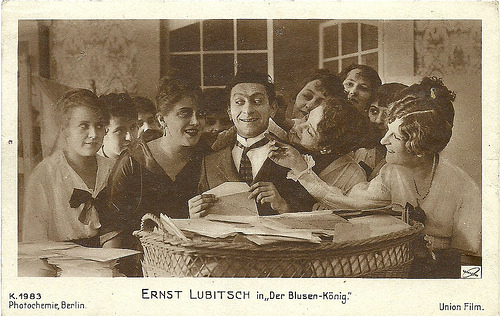
German postcard by Photochemie, no. K. 1983. Photo: Union Film. Publicity still for Der Blusen-König (Ernst Lubitsch, 1917) starring Ernst Lubitsch himself. Collection: Didier Hanson.
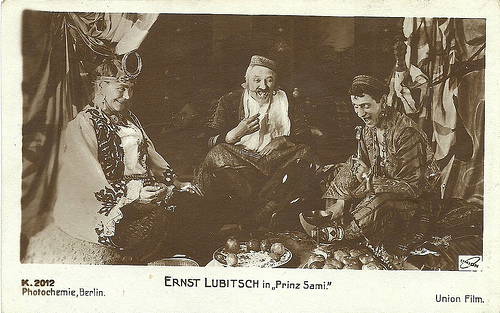
German postcard by Photochemie, Berlin, no. K. 2012. Photo: Union Film. Publicity still for Prinz Sami/Prince Sami (Ernst Lubitsch, 1918), again with Ernst Lubitsch in the leading role. Collection: Didier Hanson.
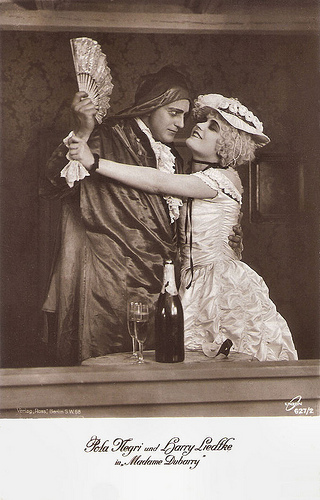
German postcard by Ross Verlag, Berlin, no. 627/2. Photo: Union. Publicity still for Madame DuBarry (Ernst Lubitsch, 1919) with Pola Negri and Harry Liedtke .
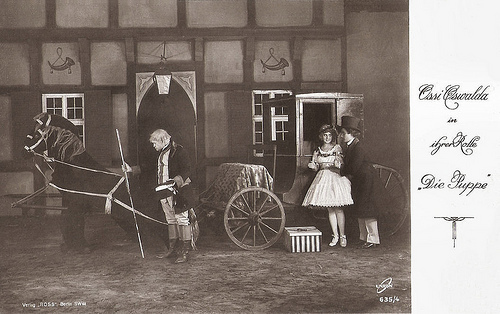
German postcard by Ross Verlag, Berlin, no. 635/4. Photo: Union. Publicity still for Die Puppe/The Doll (Ernst Lubitsch, 1919) with Ossi Oswalda and Hermann Thimig .
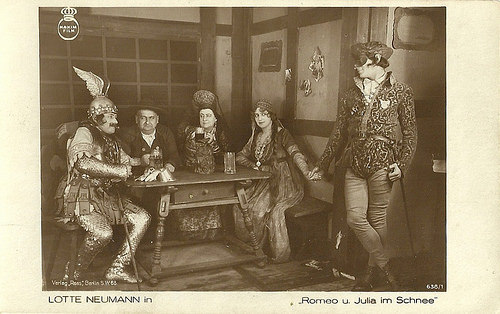
German postcard by Ross Verlag, no. 636/1. Photo: Maxim Film production. Publicity still for the comedy Romeo und Julia im Schnee/Romeo and Juliet in the Snow (Ernst Lubitsch, 1920). The man on the left dressed as antique hero could be Julius Falkenstein as Paris. The others are from left to right Jakob Tiedtke (Herr Capulethofer), Marga Köhler (his wife), Lotte Neumann (Julia) and Gustav von Wangenheim (Romeo Montekugerl).
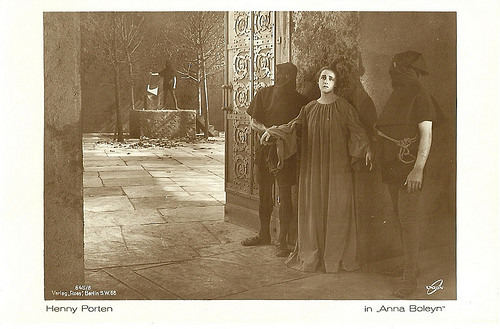
German postcard by Ross Verlag, no. 645/8. Photo: Union Film. Henny Porten in the drama Anna Boleyn (Ernst Lubitsch, 1920).
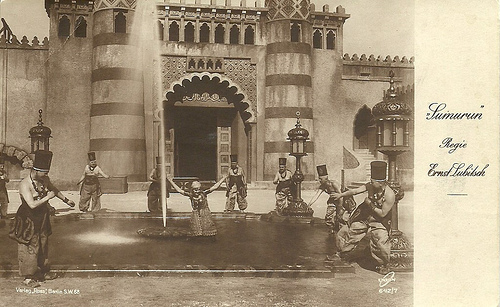
German postcard by Ross Verlag, Berlin, no. 642/7. Photo: Union Film. Publicity still for Sumurun (Ernst Lubitsch, 1920) with Pola Negri . Collection: Didier Hanson.
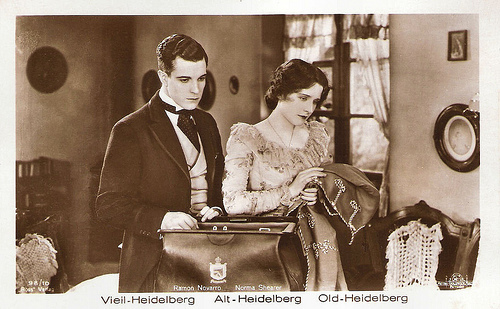
German postcard by Ross Verlag, no. 98/10. Photo: Metro-Goldwyn-Mayer. Publicity still for The Student Prince in Old Heidelberg (Ernst Lubitsch, 1927) with Ramon Novarro and Norma Shearer.
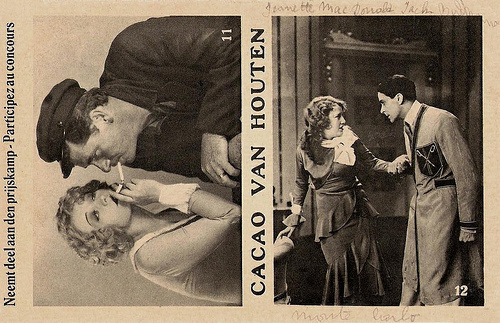
Dutch-Belgian promotion card for Cacao Van Houten, no. 11 and 12. Printed by N.V. Ned Reclamefabriek. This card was part of a series of promo cards for a quiz by Van Houten Chocolate. The public had to go to stores to guess which film star was on the photo in the shop window. There were 24 photos. At the right Jack Buchanan and Jeanette MacDonald in Monte Carlo (Ernst Lubitsch, 1930).
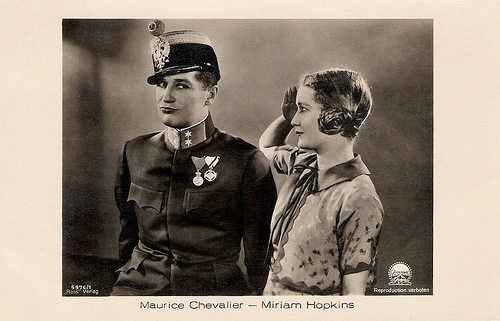
German postcard by Ross Verlag, no. 5976/1, 1931-1932. Photo: Paramount. Publicity still for The Smiling Lieutenant (Ernst Lubitsch, 1931) with Maurice Chevalier and Miriam Hopkins.
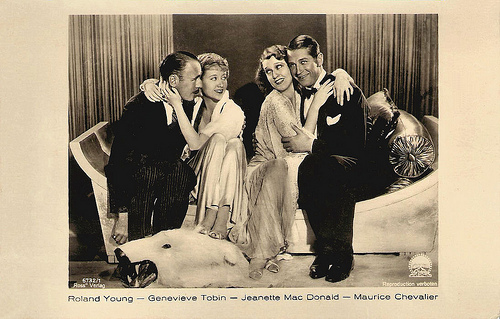
German postcard by Ross Verlag, no. 6732/1, 1931-1932. Photo: Paramount. Publicity still for One Hour with You (Ernst Lubitsch, 1932) with Roland Young, Genevieve Tobin, Jeanette MacDonald and Maurice Chevalier .
This is a post for Postcard Friendship Friday, hosted by Beth at the The Best Hearts are Crunchy. You can visit her by clicking on the button below.


Ernst Lubitsch and Ossi Oswalda . German postcard by Ross Verlag, Berlin, no. 337/1, 1919-1924. Photo: Zander & Labisch.

German postcard by Photochemie, no. K. 1983. Photo: Union Film. Publicity still for Der Blusen-König (Ernst Lubitsch, 1917) starring Ernst Lubitsch himself. Collection: Didier Hanson.

German postcard by Photochemie, Berlin, no. K. 2012. Photo: Union Film. Publicity still for Prinz Sami/Prince Sami (Ernst Lubitsch, 1918), again with Ernst Lubitsch in the leading role. Collection: Didier Hanson.

German postcard by Ross Verlag, Berlin, no. 627/2. Photo: Union. Publicity still for Madame DuBarry (Ernst Lubitsch, 1919) with Pola Negri and Harry Liedtke .

German postcard by Ross Verlag, Berlin, no. 635/4. Photo: Union. Publicity still for Die Puppe/The Doll (Ernst Lubitsch, 1919) with Ossi Oswalda and Hermann Thimig .

German postcard by Ross Verlag, no. 636/1. Photo: Maxim Film production. Publicity still for the comedy Romeo und Julia im Schnee/Romeo and Juliet in the Snow (Ernst Lubitsch, 1920). The man on the left dressed as antique hero could be Julius Falkenstein as Paris. The others are from left to right Jakob Tiedtke (Herr Capulethofer), Marga Köhler (his wife), Lotte Neumann (Julia) and Gustav von Wangenheim (Romeo Montekugerl).

German postcard by Ross Verlag, no. 645/8. Photo: Union Film. Henny Porten in the drama Anna Boleyn (Ernst Lubitsch, 1920).

German postcard by Ross Verlag, Berlin, no. 642/7. Photo: Union Film. Publicity still for Sumurun (Ernst Lubitsch, 1920) with Pola Negri . Collection: Didier Hanson.

German postcard by Ross Verlag, no. 98/10. Photo: Metro-Goldwyn-Mayer. Publicity still for The Student Prince in Old Heidelberg (Ernst Lubitsch, 1927) with Ramon Novarro and Norma Shearer.

Dutch-Belgian promotion card for Cacao Van Houten, no. 11 and 12. Printed by N.V. Ned Reclamefabriek. This card was part of a series of promo cards for a quiz by Van Houten Chocolate. The public had to go to stores to guess which film star was on the photo in the shop window. There were 24 photos. At the right Jack Buchanan and Jeanette MacDonald in Monte Carlo (Ernst Lubitsch, 1930).

German postcard by Ross Verlag, no. 5976/1, 1931-1932. Photo: Paramount. Publicity still for The Smiling Lieutenant (Ernst Lubitsch, 1931) with Maurice Chevalier and Miriam Hopkins.

German postcard by Ross Verlag, no. 6732/1, 1931-1932. Photo: Paramount. Publicity still for One Hour with You (Ernst Lubitsch, 1932) with Roland Young, Genevieve Tobin, Jeanette MacDonald and Maurice Chevalier .
This is a post for Postcard Friendship Friday, hosted by Beth at the The Best Hearts are Crunchy. You can visit her by clicking on the button below.

Published on November 26, 2015 22:00
November 25, 2015
Jenny Hasselqvist
Jenny Hasselqvist (1894-1978) was a Swedish ballet dancer and actress who starred in silent Swedish films by Mauritz Stiller and Victor Sjöström. She also worked in Germany with Ernst Lubitsch and became well-known all over Europe. With the rise of the sound film she concluded her film career.
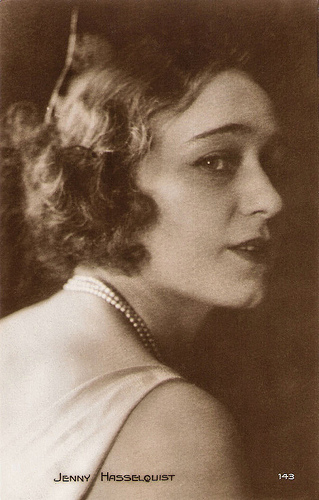
French postcard by Editions Cinémagazine, no. 143. Swedish actress Jenny Hasselqvist aka Jenny Hasselquist.
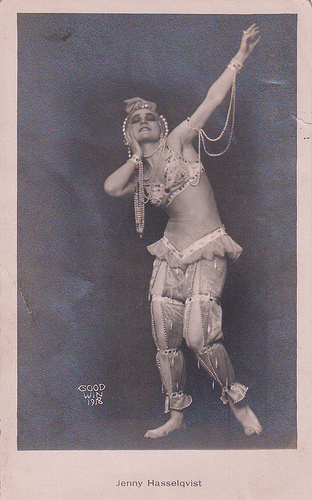
Vintage postcard. Photo: Henry B. Goodwin, 1918. Collection: Marlène Pilaete.
Prima Donna
Jenny Matilda Elisabet Hasselqvist (or Hasselquist) was born in 1894 in Stockholm, Sweden. Her father was a member of parliament. From 1906 on, Jenny attended the Swedish Opera's ballet school and from 1910, she performed with the Royal Ballet.
In 1913, famous Russian choreographer Michel Fokine noticed her talents and ensured she obtained solo parts in La Sylphide and Cleopatra. She had a brilliant success and became a prima ballerina at the Royal Ballet in 1915.
In 1916, Hasselqvist made her film debut in Balettprimadonnan/Anjala the Dancer, directed by the legendary Mauritz Stiller. She got the title role because it required a professional dancer. At IMDb , ‘Herr Graf’ Ferdinand Von Galitzien highly recommends the film of which now only some fragments remain. ‘Genuine Stiller’, he calls the tale of a gypsy dancer (Hasselquist) who is discovered accidentally by a violin player ( Lars Hanson ). Von Galitzien about the film’s ending: “a thrilling sequence with our heroine running wild through a snowy landscape trying to avoid a calamity between the men that are fighting for her love (…), a lyrical and beautiful ending wherein Nature (Swedish style) is also an important dramatic character.”
Hasselqvist continued to dance. In 1919, she retired from the Royal Ballet, and became from 1919 till 1921 a star of Les ballets Anglais in Paris. Wikipedia : “A talented dancer, she had a flair for the modern idiom.” She also pursued a career in the silent cinema. With Mauritz Stiller, she made Johan/ Rapids of Life (Mauritz Stiller, 1921) with Mathias Taube and De landsflyktige/The Emigrants (Mauritz Stiller, 1921).
Then she worked with the other great director of the Swedish silent cinema, Victor Sjöström at Vem dömer/Love’s Crucible (Victor Sjöström, 1922) with Gösta Ekman , and Eld ombord/Fire on Board (Victor Sjöström, 1923) opposite British actor Matheson Lang and Victor Sjöström himself.
One of her best known films is Gösta Berlings saga/The Atonement of Gosta Berling (Mauritz Stiller, 1924) starring Lars Hanson and the young Greta Garbo . Hal Erickson at AllMovie : “The Atonement of Gosta Berling is an excellent representation of the Swedish silent cinema. Long, complex, and elaborately produced, the film nonetheless never loses sight of the human elements which motivate the story.”
Hasselqvist also worked with Gustaf Molander at the Selma Lagerlöf adaptations Ingmarsarvet/The Ingmar Inheritance (Gustaf Molander, 1925) and Till österland/To the Orient (Gustaf Molander, 1926), with Lars Hanson and Ivan Hedqvist.
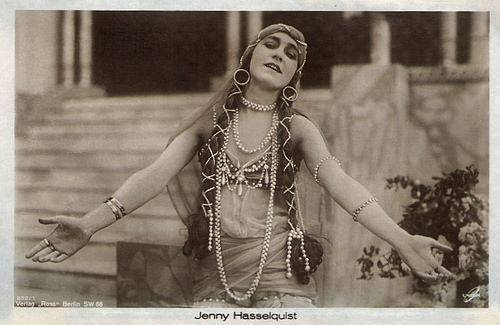
German postcard by Ross Verlag, Berlin, no. 832/1, 1919-1924. Union Film. Publicity still for Sumurun (Ernst Lubitsch, 1920).
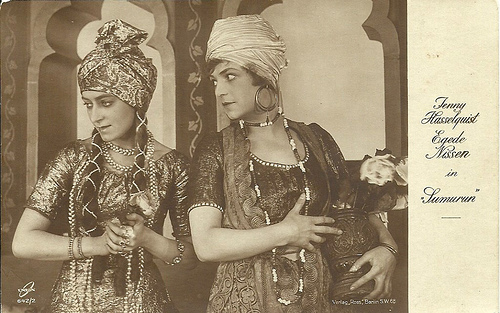
German postcard by Ross Verlag, Berlin, no. 642/2,1919-1924. Union Film. Publicity still for Sumurun (Ernst Lubitsch, 1920) with Jenny Hasselquist and Aud Egede Nissen . Collection: Didier Hanson.
Sumurun
Jenny Hasselqvist also worked in Germany. In 1920, Ernst Lubitsch offered her the title role in his film version of Max Reinhardt's stage pantomime Sumurun/One Arabian Night (Ernst Lubitsch, 1920), opposite Ernst Lubitsch himself and Pola Negri . Hasselqvist played the favourite slave girl of a tyrannical sheik ( Paul Wegener ), who falls in love with a cloth merchant ( Harry Liedtke ). The film was huge international success and she became well-known in Europe.
In Germany she also played in Das brennende Geheimnis/The Burning Secret (Rochus Gliese, 1923) and Die Perücke/The Wig (Berthold Viertel, 1925) as the wife of Otto Gebühr . About the latter Gwynplaine writes at IMDb : “It's been ten years since I seen Berthold Viertel's compelling film Die Perucke (or the Wig) at the Pordenone Silent Film Festival back in 1997. But of all the films I seen throughout that eventful week (including some impressive silents from China...) I would have to say that Die Perucke was the most impressive. The story concerns a man in the 1920s who, while visiting an antique shop, discovers an old powdered wig. While trying the wig on he is instantly whisked back to the 1700's & becomes the nobleman who originally wore the wig.”
Hasselqvist’s later German films include Brennende Grenze/Aftermath (Erich Waschneck, 1927) and Schuldig/Guilty (Johannes Meyer, 1928) with Suzy Vernon . With the rise of the sound film she concluded her film career. Her final film was the Paramount production Den farliga leken (Gustaf Bergman, 1931), an alternative language version of The Laughing Lady (Victor Schertzinger, 1929) with Ruth Chatterton.
Hasselqvist had starred in 20 films, but the voice was not her medium. During her film career, she had appeared as a guest dancer in many of Europe's leading theatres including the Coliseum in London, the Théâtre des Champs-Élysées in Paris and the Deutsches Theater in Berlin. From the mid-1930s on, she had her own ballet school in Stockholm, and in the early 1950s, she also taught at the Stockholm Opera's ballet school. In between she incidentally returned to act on stage.
At the age of 83, Jenny Hasselqvist died in 1978 in Täby, near Stockholm. She was married with artist, painter and ceramist Wilhelm Kage (1918-1922) and with garden architect Gösta Reuterswärd (1923-1927).
Short dance fragment of Jenny Hasselquist performing Die weiße Rose (The White Rose), from the German 'health and efficiency' film Wege Zu Kraft und Schonheit/Paths to the Power & Beauty (1925). Source: John Hall (YouTube).
Homage to Lars Hanson and Jenny Hasselqvist in 1924, with Cristal um tango sung by Francisco Alves. Source: Radio Santos (YouTube).
Sources: Ferdinand Von Galitzien (IMDb), Gwynplaine (IMDb), Bengt Forslund (The Swedish Film Database - Swedish), Wikipedia (English and Swedish) and .

French postcard by Editions Cinémagazine, no. 143. Swedish actress Jenny Hasselqvist aka Jenny Hasselquist.

Vintage postcard. Photo: Henry B. Goodwin, 1918. Collection: Marlène Pilaete.
Prima Donna
Jenny Matilda Elisabet Hasselqvist (or Hasselquist) was born in 1894 in Stockholm, Sweden. Her father was a member of parliament. From 1906 on, Jenny attended the Swedish Opera's ballet school and from 1910, she performed with the Royal Ballet.
In 1913, famous Russian choreographer Michel Fokine noticed her talents and ensured she obtained solo parts in La Sylphide and Cleopatra. She had a brilliant success and became a prima ballerina at the Royal Ballet in 1915.
In 1916, Hasselqvist made her film debut in Balettprimadonnan/Anjala the Dancer, directed by the legendary Mauritz Stiller. She got the title role because it required a professional dancer. At IMDb , ‘Herr Graf’ Ferdinand Von Galitzien highly recommends the film of which now only some fragments remain. ‘Genuine Stiller’, he calls the tale of a gypsy dancer (Hasselquist) who is discovered accidentally by a violin player ( Lars Hanson ). Von Galitzien about the film’s ending: “a thrilling sequence with our heroine running wild through a snowy landscape trying to avoid a calamity between the men that are fighting for her love (…), a lyrical and beautiful ending wherein Nature (Swedish style) is also an important dramatic character.”
Hasselqvist continued to dance. In 1919, she retired from the Royal Ballet, and became from 1919 till 1921 a star of Les ballets Anglais in Paris. Wikipedia : “A talented dancer, she had a flair for the modern idiom.” She also pursued a career in the silent cinema. With Mauritz Stiller, she made Johan/ Rapids of Life (Mauritz Stiller, 1921) with Mathias Taube and De landsflyktige/The Emigrants (Mauritz Stiller, 1921).
Then she worked with the other great director of the Swedish silent cinema, Victor Sjöström at Vem dömer/Love’s Crucible (Victor Sjöström, 1922) with Gösta Ekman , and Eld ombord/Fire on Board (Victor Sjöström, 1923) opposite British actor Matheson Lang and Victor Sjöström himself.
One of her best known films is Gösta Berlings saga/The Atonement of Gosta Berling (Mauritz Stiller, 1924) starring Lars Hanson and the young Greta Garbo . Hal Erickson at AllMovie : “The Atonement of Gosta Berling is an excellent representation of the Swedish silent cinema. Long, complex, and elaborately produced, the film nonetheless never loses sight of the human elements which motivate the story.”
Hasselqvist also worked with Gustaf Molander at the Selma Lagerlöf adaptations Ingmarsarvet/The Ingmar Inheritance (Gustaf Molander, 1925) and Till österland/To the Orient (Gustaf Molander, 1926), with Lars Hanson and Ivan Hedqvist.

German postcard by Ross Verlag, Berlin, no. 832/1, 1919-1924. Union Film. Publicity still for Sumurun (Ernst Lubitsch, 1920).

German postcard by Ross Verlag, Berlin, no. 642/2,1919-1924. Union Film. Publicity still for Sumurun (Ernst Lubitsch, 1920) with Jenny Hasselquist and Aud Egede Nissen . Collection: Didier Hanson.
Sumurun
Jenny Hasselqvist also worked in Germany. In 1920, Ernst Lubitsch offered her the title role in his film version of Max Reinhardt's stage pantomime Sumurun/One Arabian Night (Ernst Lubitsch, 1920), opposite Ernst Lubitsch himself and Pola Negri . Hasselqvist played the favourite slave girl of a tyrannical sheik ( Paul Wegener ), who falls in love with a cloth merchant ( Harry Liedtke ). The film was huge international success and she became well-known in Europe.
In Germany she also played in Das brennende Geheimnis/The Burning Secret (Rochus Gliese, 1923) and Die Perücke/The Wig (Berthold Viertel, 1925) as the wife of Otto Gebühr . About the latter Gwynplaine writes at IMDb : “It's been ten years since I seen Berthold Viertel's compelling film Die Perucke (or the Wig) at the Pordenone Silent Film Festival back in 1997. But of all the films I seen throughout that eventful week (including some impressive silents from China...) I would have to say that Die Perucke was the most impressive. The story concerns a man in the 1920s who, while visiting an antique shop, discovers an old powdered wig. While trying the wig on he is instantly whisked back to the 1700's & becomes the nobleman who originally wore the wig.”
Hasselqvist’s later German films include Brennende Grenze/Aftermath (Erich Waschneck, 1927) and Schuldig/Guilty (Johannes Meyer, 1928) with Suzy Vernon . With the rise of the sound film she concluded her film career. Her final film was the Paramount production Den farliga leken (Gustaf Bergman, 1931), an alternative language version of The Laughing Lady (Victor Schertzinger, 1929) with Ruth Chatterton.
Hasselqvist had starred in 20 films, but the voice was not her medium. During her film career, she had appeared as a guest dancer in many of Europe's leading theatres including the Coliseum in London, the Théâtre des Champs-Élysées in Paris and the Deutsches Theater in Berlin. From the mid-1930s on, she had her own ballet school in Stockholm, and in the early 1950s, she also taught at the Stockholm Opera's ballet school. In between she incidentally returned to act on stage.
At the age of 83, Jenny Hasselqvist died in 1978 in Täby, near Stockholm. She was married with artist, painter and ceramist Wilhelm Kage (1918-1922) and with garden architect Gösta Reuterswärd (1923-1927).
Short dance fragment of Jenny Hasselquist performing Die weiße Rose (The White Rose), from the German 'health and efficiency' film Wege Zu Kraft und Schonheit/Paths to the Power & Beauty (1925). Source: John Hall (YouTube).
Homage to Lars Hanson and Jenny Hasselqvist in 1924, with Cristal um tango sung by Francisco Alves. Source: Radio Santos (YouTube).
Sources: Ferdinand Von Galitzien (IMDb), Gwynplaine (IMDb), Bengt Forslund (The Swedish Film Database - Swedish), Wikipedia (English and Swedish) and .
Published on November 25, 2015 22:00
Paul van Yperen's Blog
- Paul van Yperen's profile
- 13 followers
Paul van Yperen isn't a Goodreads Author
(yet),
but they
do have a blog,
so here are some recent posts imported from
their feed.



